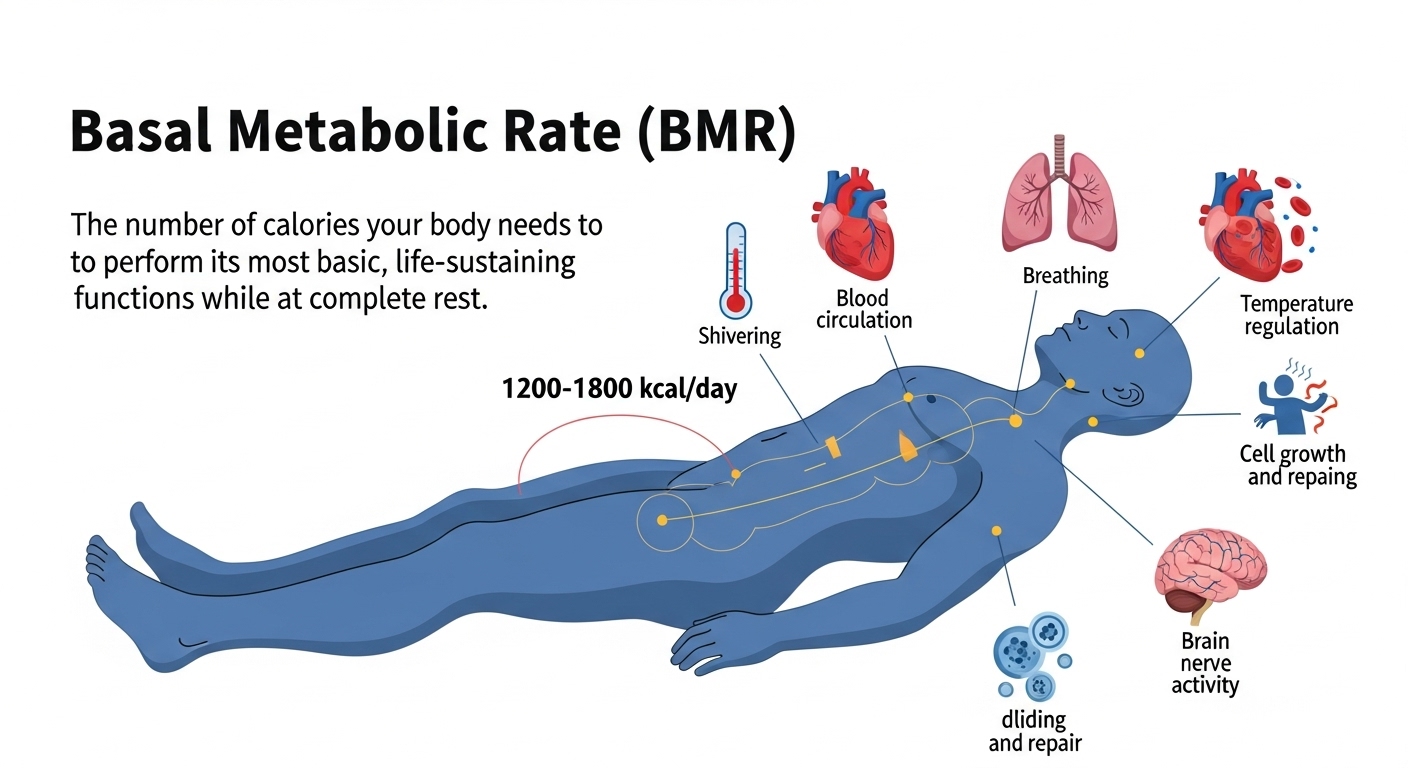Nutrition Plans
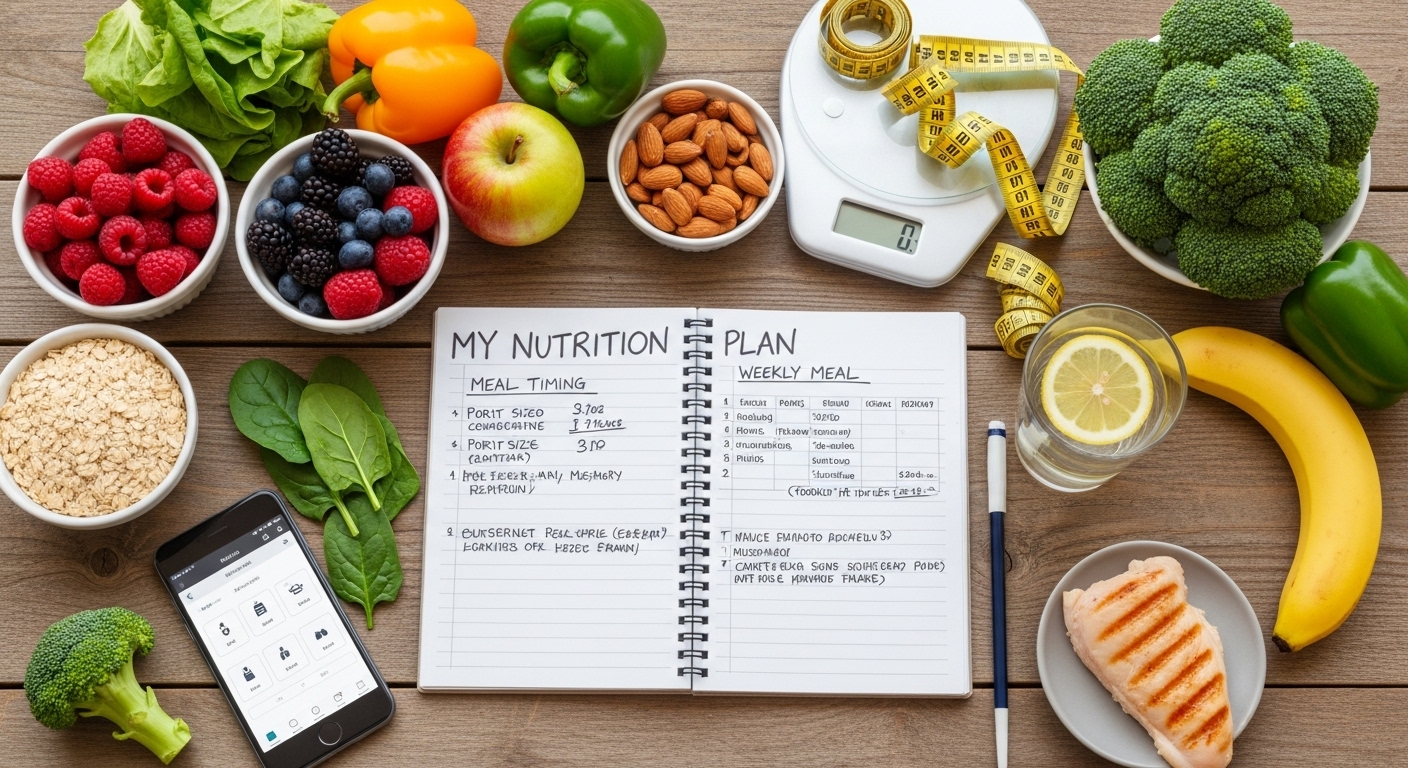
A Nutrition Plan is a structure and personalized guide. It focuses on providing the right balance of nutrients such as proteins, carbohydrates, fats, vitamins and minerals to contribute to the results of damage or health management.
Introduction to Nutrition Plans
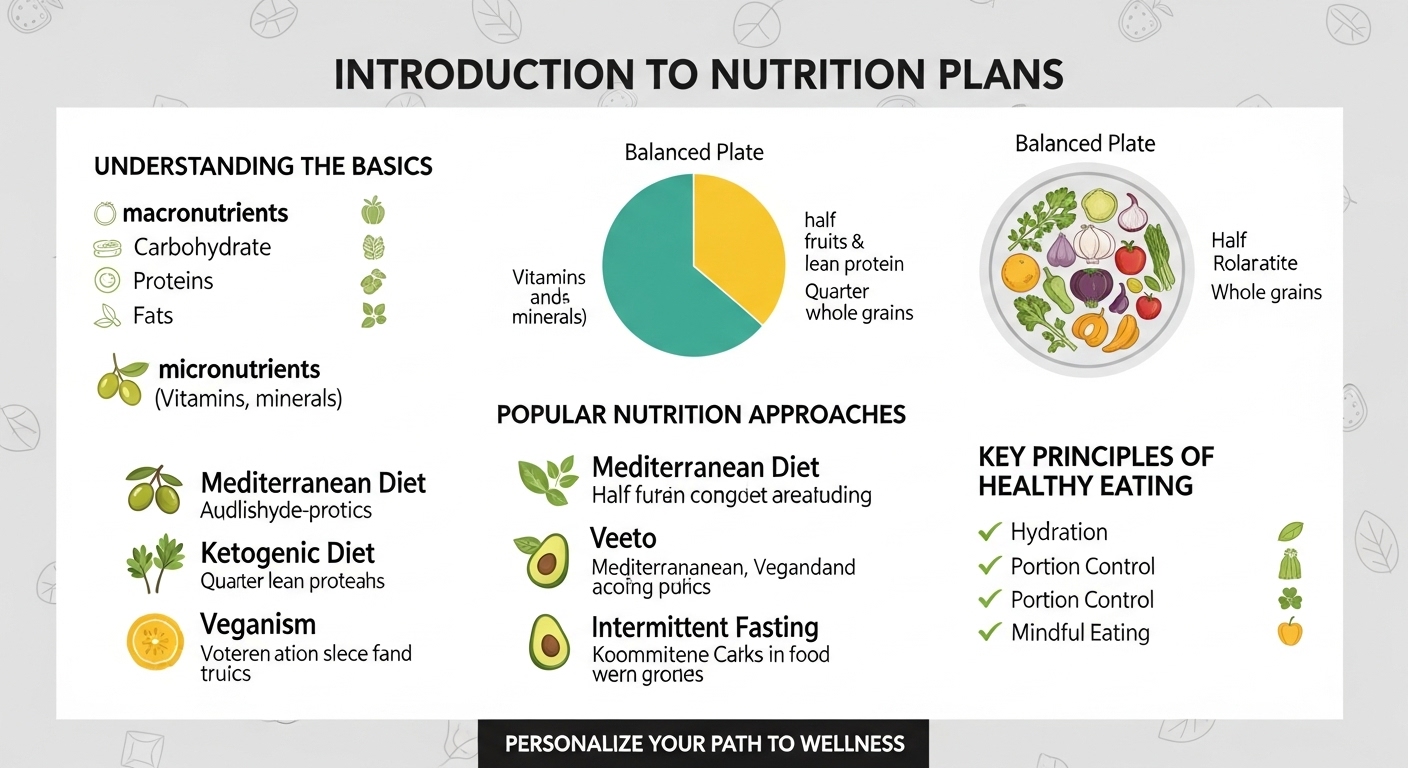
Personalized food strategies designed to help people in achieving specific health or fitness goals of nutrition plans. The goal is to lose weight, build muscles, maintain medical condition or maintain the whole health, and provide a clear roadmap to make a well -structured nutrition plan information food options.
These plans examine aspects such as a person's age, gender, operational level, metabolism and personal preferences. Macronutrients (proteins, carbohydrates, fats) and focus on the proper balance of micronutrients (vitamins, minerals), nutritional plans, support for proper physical functions, energy levels and long -term health.
Adopting a nutrition plan improves digestion, boosts immunity, boosts physical function, and promotes constant eating habits. It helps in preventing nutritional disorders and excessive ones, which contributes to good quality of life.
What is a Nutrition Plan?
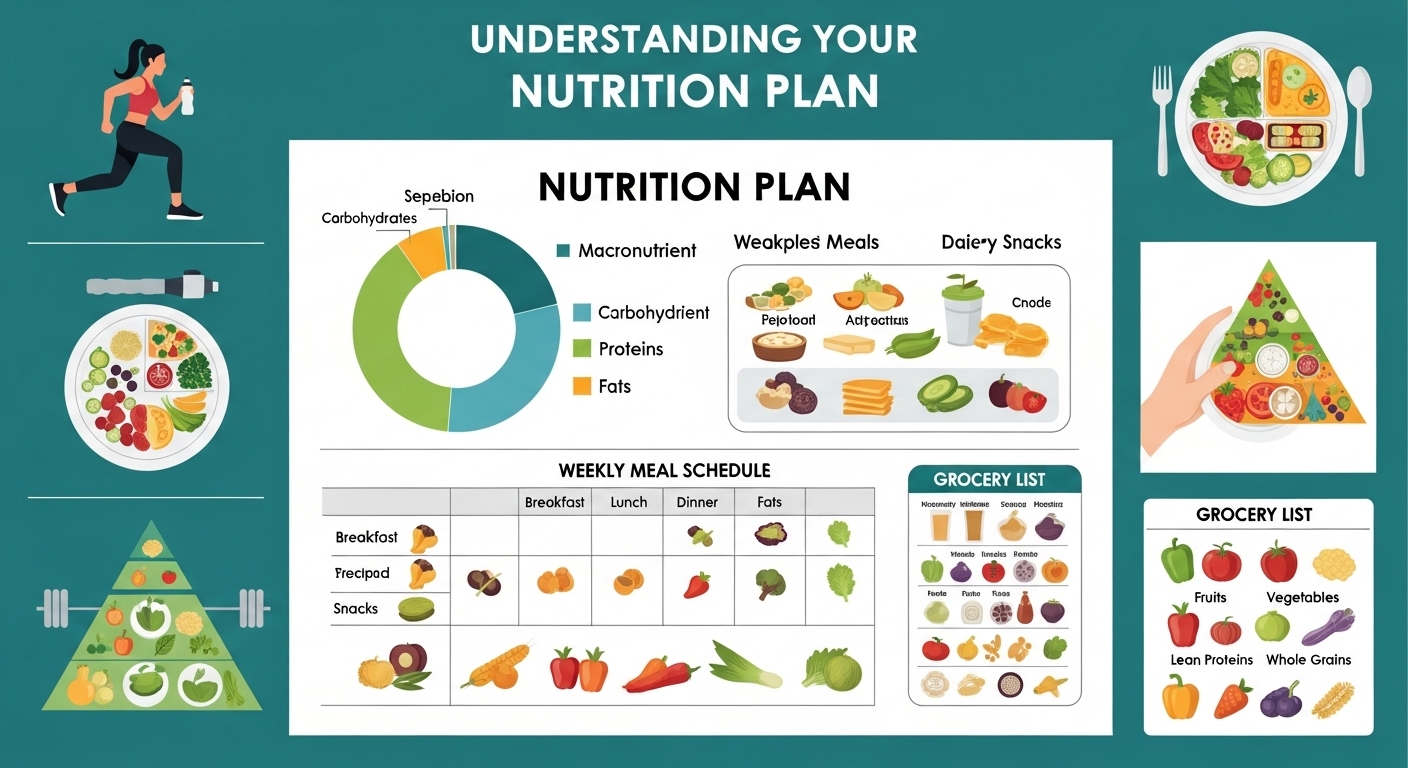
A Nutrition Plan is a structural approach to eating, which stipulates the foods, part sizes and dining time for a person's health, fitness or medical goals. Unlike random dieting, nutrition plan is personalized, taking into account age, weight, operational level, metabolism and health conditions.
It is designed to get the body to obtain the proper balance of macronutrients (proteins, carbohydrates, fats) and micronutrients (vitamins, minerals) for energy, growth and overall well -being. A good nutrition plan promotes healthy eating habits, prevents nutritional deficiencies and supports long -term lifestyle changes than quick solutions.
Importance of Nutrition Planning
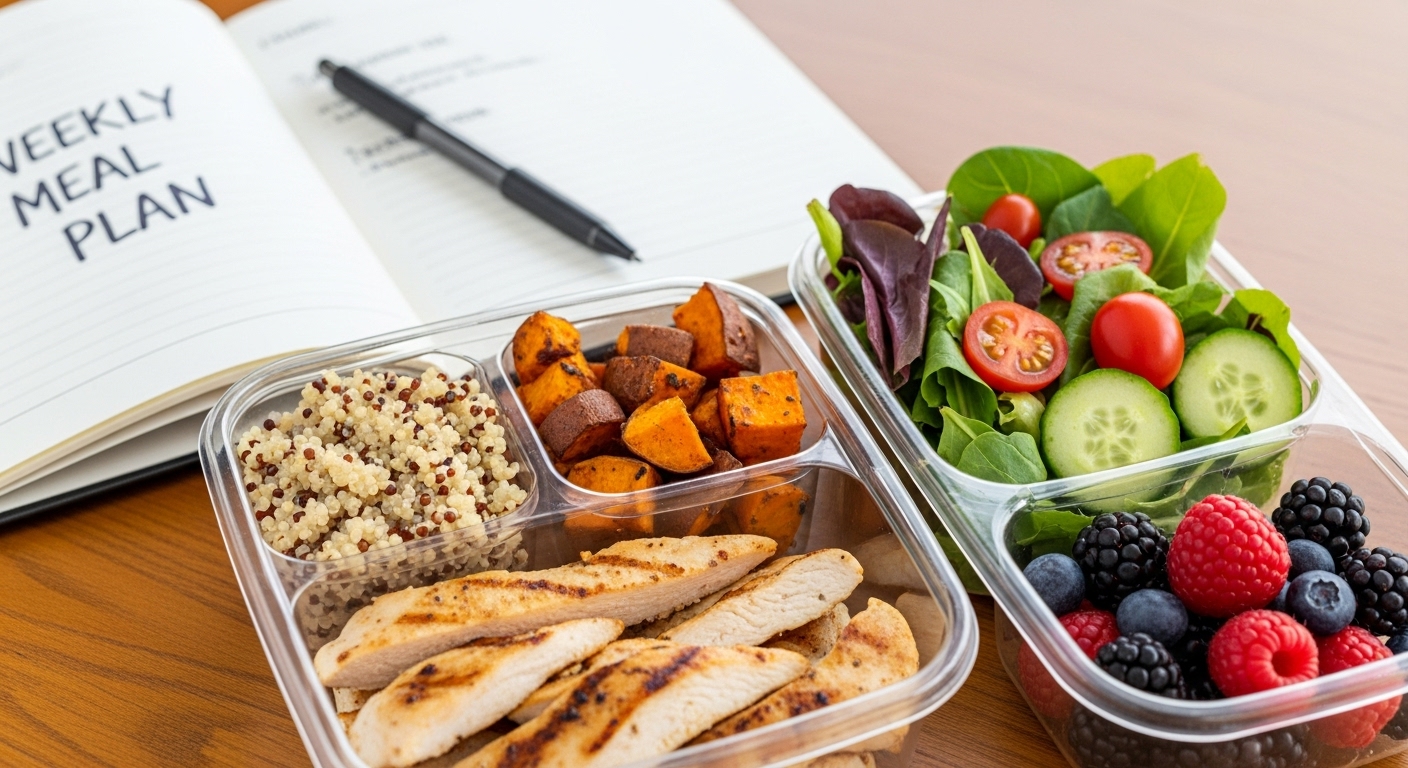
Nutrition plan is important to maintain good health, achieve fitness goals and prevent lifestyle diseases. It is not beyond to eat healthy -which provides a structural approach to your body to get the right nutrients at the right time. Why is it important here:
-
Overall Health Support:: A well -designed nutrition plan ensures that your body gets the necessary nutrients for energy, growth and proper functioning of the organs.
-
Prevents Nutritional Deficiencies: Planning to prevent general disorders in vitamins, minerals and macronutrients, leading to health problems such as fatigue, weak immunity and bone health.
-
Effectively handles weight: Your goal is to lose weight, muscle growth or maintenance, nutritious planning provides proper calories and provide nutritional balance to reach it.
-
Improves physical and mental function: Awesome nutrition is the same as a vulgar, concentration and overall productivity, which is the same for athletes, students and professionals.
-
The disease supports the prevention and maintenance of the disease: Customized plans help to control the conditions such as diabetes, hypertension, heart disease and ES in controlling nutritional intake and dining time.
-
Promotes healthy eating habits: Having a plan reduces the tendency to skip meals or overeating and helps to build stable, intellectual feeding techniques.
Key Components of a Nutrition Plan
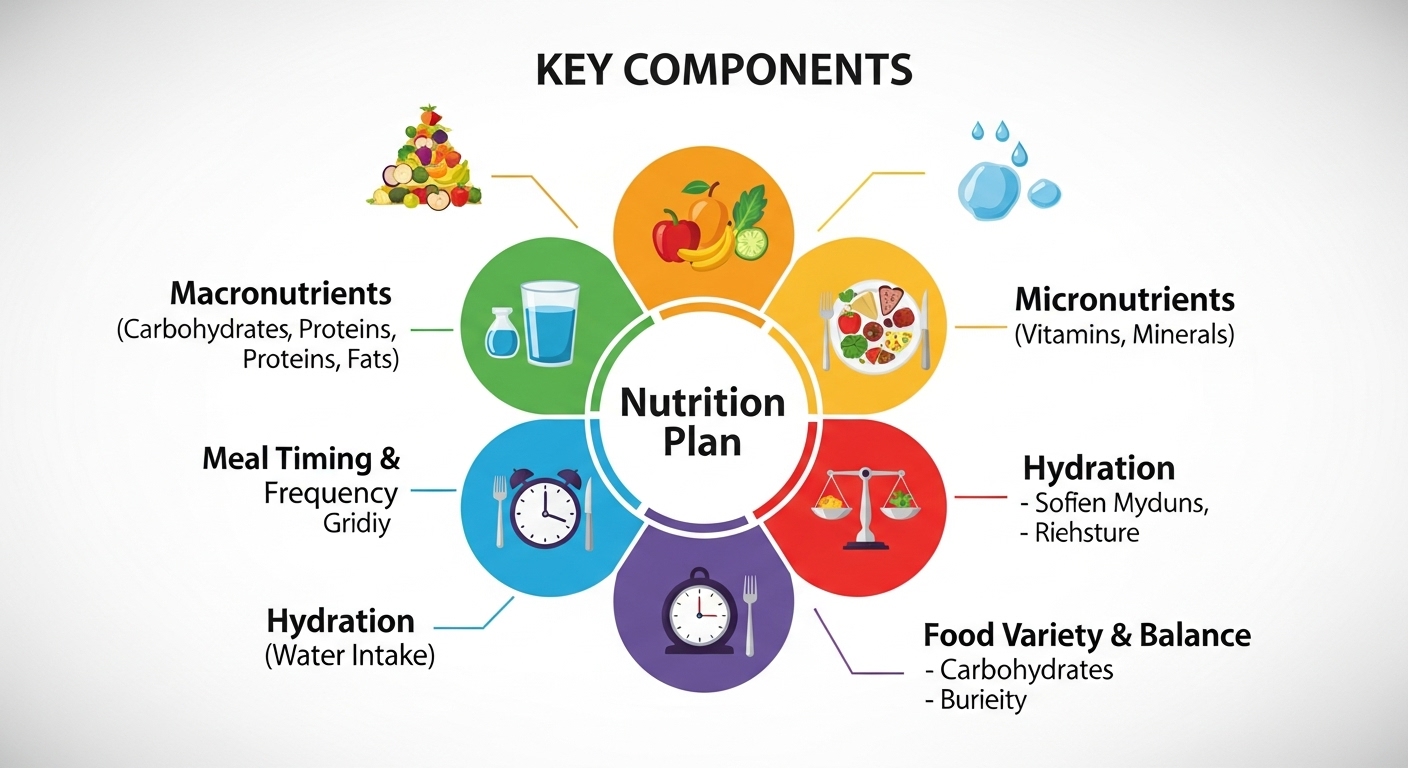
A well -constructive nutrition plan focuses on balance, variation and control. Here are the required parts:
-
1. Taking calories
All calories you eat should match your goal:
- Weight loss → Calories deficit
- Muscle Gain → Caloric surplus
- Maintenance → Balance of calories
Based on the basal metabolic rate (BMR), operational level and targets.
-
2. Macronutrients
Proteins: Muscle repair, growth and total health are required.
Sources: Thin meats, eggs, legumes, dairy, tofu.
Carbohydrates: The basic energy source for the body and the brain.
Sources:Whole grains, fruits and vegetables.
Fats: Hormonal production, brain health and energy.
Roots Nuts, seeds, avocados, healthy oils.
-
3. Micronutrients
Vitamins & Minerals: Support immunity, bone health, and metabolic functions.
Sources: Fresh fruits, vegetables, nuts, seeds, dairy.
-
4. Hydration
Water is critical for digestion, nutrient absorption, and detoxification.
Aim for: 8–10 glasses per day (varies by body size and activity).
-
5. Meal Timing and Frequency
Distribute calories and nutrients throughout the day for sustained energy.
Examples: 3 main meals + 2 healthy snacks.
-
6. Portion Control
Avoid overeating by using appropriate portion sizes.
Techniques: Plate method, hand-measure guide.
-
7. Personalization
Tailored to age, gender, activity level, health conditions, and preferences.
May include special considerations like vegan, gluten-free, or diabetic-friendly options.
Caloric Intake
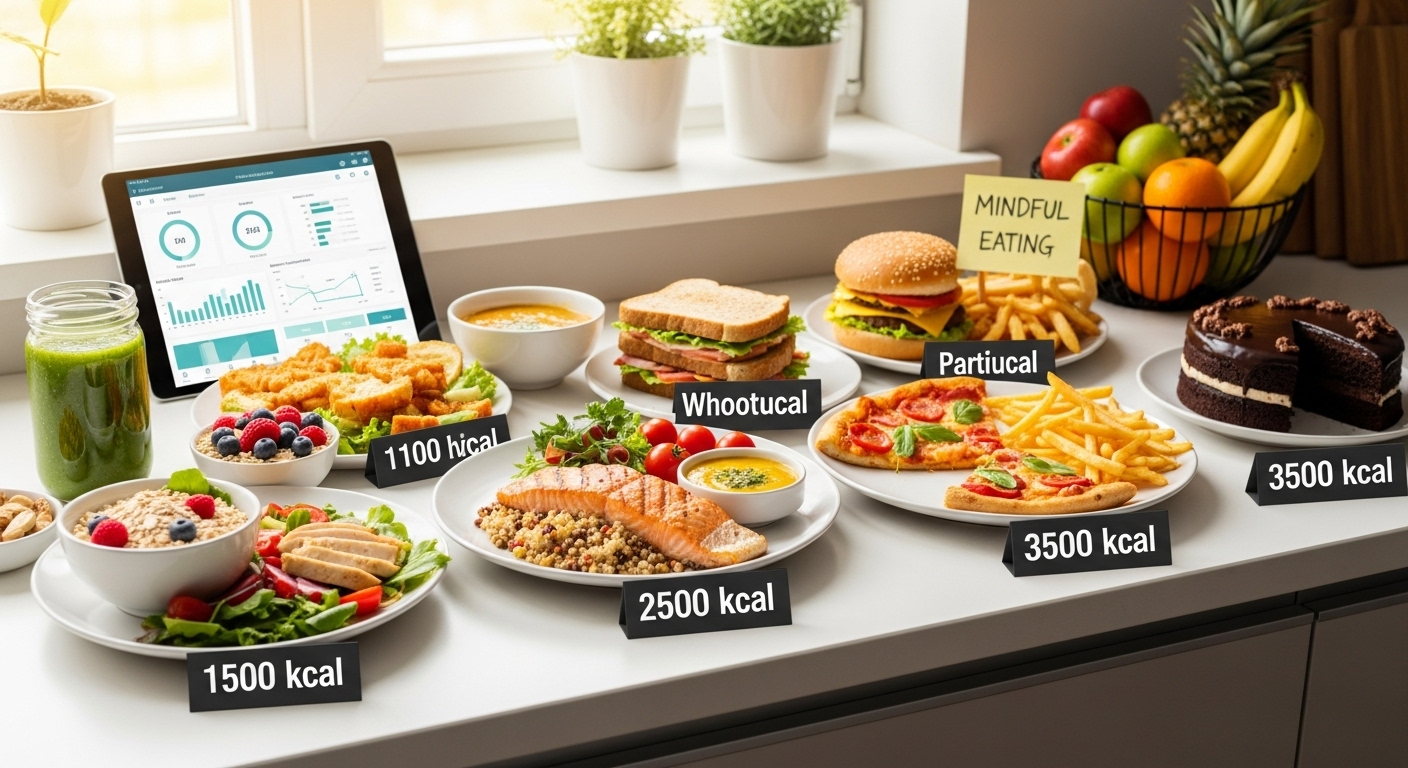
Caloric intake refers to the total number of calories consumed through food and drinks in a day. Calories are the units of energy your body uses to perform essential functions like breathing, digestion, and physical activity. Proper caloric intake is the foundation of any nutrition plan and directly affects your health and fitness goals.
Why is Caloric Intake Important?
- Energy Balance: Calories fuel your body. Too few can lead to fatigue and nutrient deficiencies, while too many can cause weight gain.
Weight Management
- Caloric Deficit: Consume fewer calories than you burn → Weight Loss
- Caloric Surplus: Consume more calories than you burn → Muscle Gain
- Maintenance: Calories in = Calories out → Weight Stability
How to Calculate Your Caloric Needs
- Determine BMR (Basal Metabolic Rate): The number of calories your body needs at rest.
- Formula (Mifflin-St Jeor):
- Men: BMR = 10 × weight (kg) + 6.25 × height (cm) – 5 × age + 5
- Women: BMR = 10 × weight (kg) + 6.25 × height (cm) – 5 × age – 161
- Add Activity Level (TDEE):
- Sedentary: BMR × 1.2
- Lightly Active: BMR × 1.375
- Moderately Active: BMR × 1.55
- Very Active: BMR × 1.725
- Adjust for Goals:
- Weight Loss: Subtract 300–500 calories/day
- Muscle Gain: Add 300–500 calories/day
Example
Person: 70 kg, 170 cm, 25 years, lightly active
BMR = 10×70 + 6.25×170 – 5×25 + 5 = 1668 kcal
TDEE = 1668 × 1.375 = 2291 kcal
For Weight Loss → 2291 – 500 = 1791 kcal/day
Micronutrients: Vitamins & Minerals
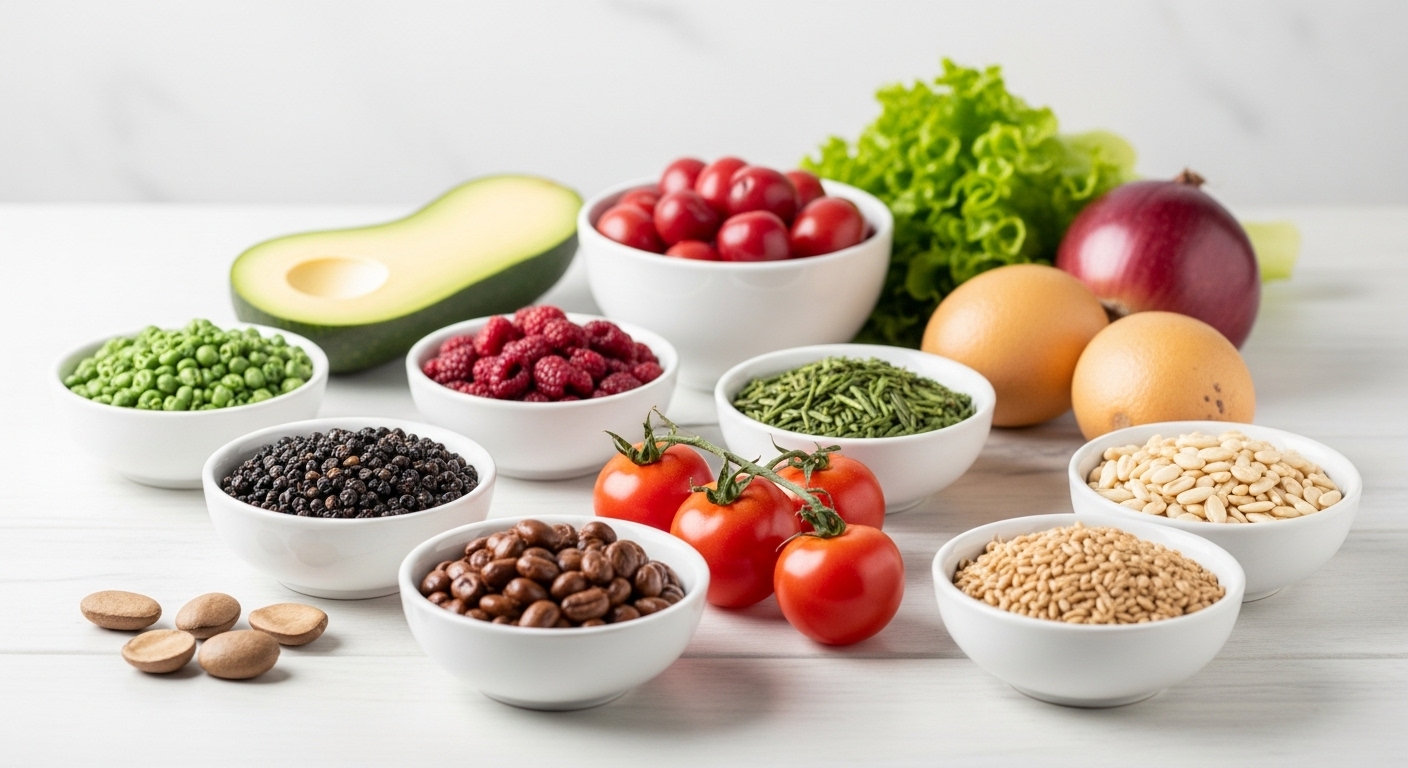
Micronutrients are essential vitamins and minerals required in small amounts to support immunity, bone health, metabolism, and many vital bodily functions.
Key Vitamins
- Vitamin A: Supports vision, skin health, and immune function.
- Vitamin C: Antioxidant that aids tissue repair and immune defense.
- Vitamin D: Crucial for calcium absorption and bone strength.
- Vitamin E: Protects cells from oxidative damage.
- Vitamin K: Important for blood clotting and bone metabolism.
Essential Minerals
- Calcium: Builds strong bones and teeth.
- Iron: Vital for oxygen transport in blood.
- Magnesium: Supports muscle and nerve function.
- Potassium: Helps regulate fluid balance and muscle contractions.
- Zinc: Aids immune response and wound healing.
Sources: Fresh fruits, vegetables, nuts, seeds, dairy products, and whole grains are rich in micronutrients and should be included regularly in your diet.
Macronutrients: Proteins, Carbs, and Fats
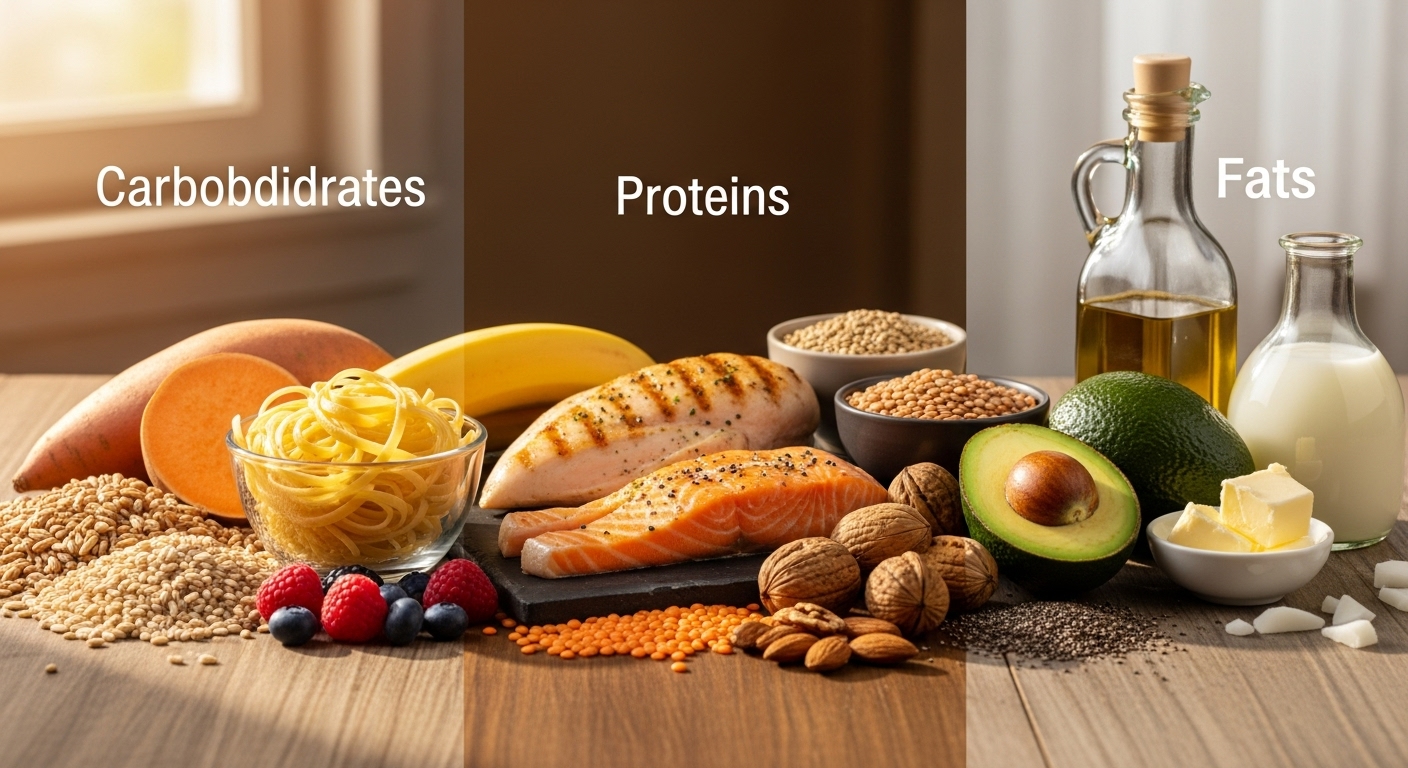
Macronutrients are the main nutrients that provide energy (calories) to the body. They are essential for growth, repair, and overall body function. The three key macronutrients are:
1. Proteins
- Role:
- Builds and repairs muscles and tissues.
- Supports immune function and enzyme production.
- Calories per gram: 4 kcal
- Daily Requirement: 0.8–2.2 g per kg of body weight (higher for athletes).
- Sources: Lean meats (chicken, fish, turkey), eggs, legumes (beans, lentils), dairy, tofu, soy, nuts.
2. Carbohydrates
- Role:
- Primary energy source for the body and brain.
- Provides fiber for digestion and gut health.
- Calories per gram: 4 kcal
- Daily Requirement: 45–65% of total daily calories.
- Types:
- Complex Carbs: Whole grains, brown rice, oats, vegetables.
- Simple Carbs: Fruits, honey (limit refined sugars).
- Sources: Whole grains, fruits, vegetables, legumes.
3. Fats
- Role:
- Supports hormone production and brain health.
- Provides long-term energy storage and aids in nutrient absorption.
- Calories per gram: 9 kcal
- Daily Requirement: 20–35% of total daily calories.
- Types:
- Healthy Fats: Unsaturated fats (avocado, olive oil, nuts, seeds).
- Unhealthy Fats: Limit saturated and trans fats (fried foods, processed snacks).
- Sources: Nuts, seeds, fatty fish (salmon), avocado, olive oil.
Recommended Macronutrient Distribution
- Proteins: 15–30% of total calories
- Carbohydrates: 45–55% of total calories
- Fats: 20–30% of total calories
Hydration

Hydration is the process of maintaining an adequate balance of fluids in the body, which is essential for overall health and proper physiological functioning. Water makes up about 60% of the human body and is involved in nearly every bodily process.
Why is Hydration Important?
- Regulates Body Temperature: Helps cool the body through sweating.
- Supports Digestion: Aids in breaking down food and nutrient absorption.
- Flushes Toxins: Assists the kidneys in removing waste products.
- Maintains Blood Volume and Circulation: Ensures efficient delivery of oxygen and nutrients.
- Protects Joints and Tissues: Acts as a lubricant and cushion.
How Much Water Do You Need?
General recommendation: 8–10 glasses (about 2 to 2.5 liters) per day.
Needs vary based on factors such as age, weight, activity level, climate, and health status.
More hydration is needed during exercise, hot weather, or illness.
Sources of Hydration
- Water: The best source for hydration.
- Other Fluids: Herbal teas, milk, and natural fruit juices (in moderation).
- Foods: Fruits and vegetables like watermelon, cucumber, oranges, and lettuce contain high water content.
Tips for Staying Hydrated
- Carry a water bottle throughout the day.
- Drink water before, during, and after exercise.
- Monitor urine color: light yellow usually indicates proper hydration.
- Avoid excessive sugary drinks and caffeine which can dehydrate.
Meal Timing and Frequency
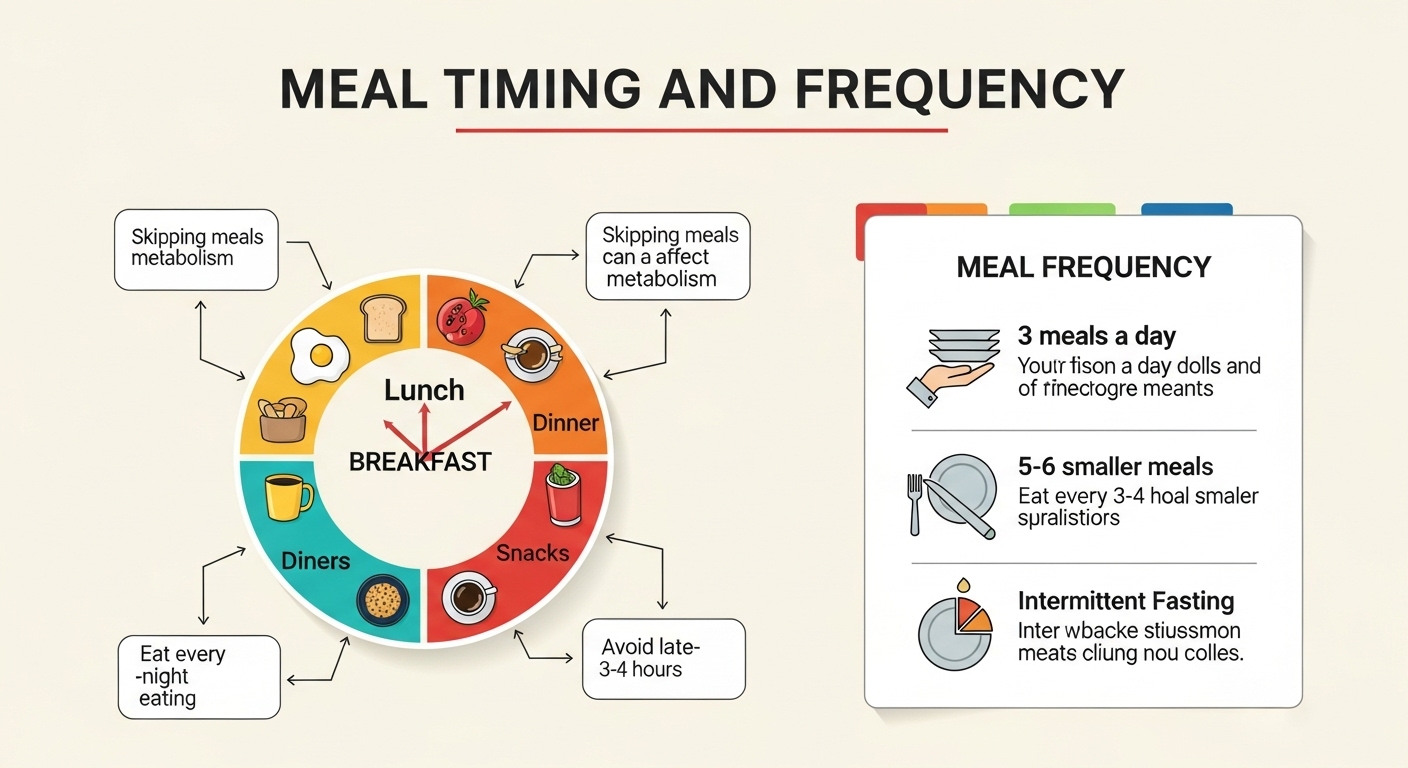
Meal timing and frequency refer to when and how often you eat throughout the day. Properly planning your meals helps optimize energy levels, digestion, metabolism, and overall health.
Why is Meal Timing Important?
- Maintains Stable Energy Levels: Eating at regular intervals prevents energy dips and spikes in blood sugar.
- Supports Metabolism: Regular meals can help keep your metabolic rate steady.
- Improves Digestion: Smaller, frequent meals can be easier to digest and help reduce bloating or discomfort.
- Enhances Nutrient Absorption: Spacing meals allows your body to absorb nutrients efficiently.
Common Meal Patterns
- 3 Meals a Day: Breakfast, lunch, and dinner — a traditional and balanced approach.
- 5-6 Smaller Meals: Includes snacks between main meals to prevent hunger and maintain energy.
- Intermittent Fasting: Eating within a specific window (e.g., 8 hours) and fasting the rest — popular for weight management but not suitable for everyone.
Tips for Effective Meal Timing
- Don’t skip breakfast — it kickstarts your metabolism.
- Space meals 3–4 hours apart to avoid overeating.
- Include balanced macronutrients in each meal for sustained energy.
- Listen to your body’s hunger cues rather than eating out of habit or boredom.
Personalization
Meal timing should suit your lifestyle, work schedule, and preferences. Athletes, shift workers, or those with medical conditions might require specific adjustments.
Types of Nutrition Plans
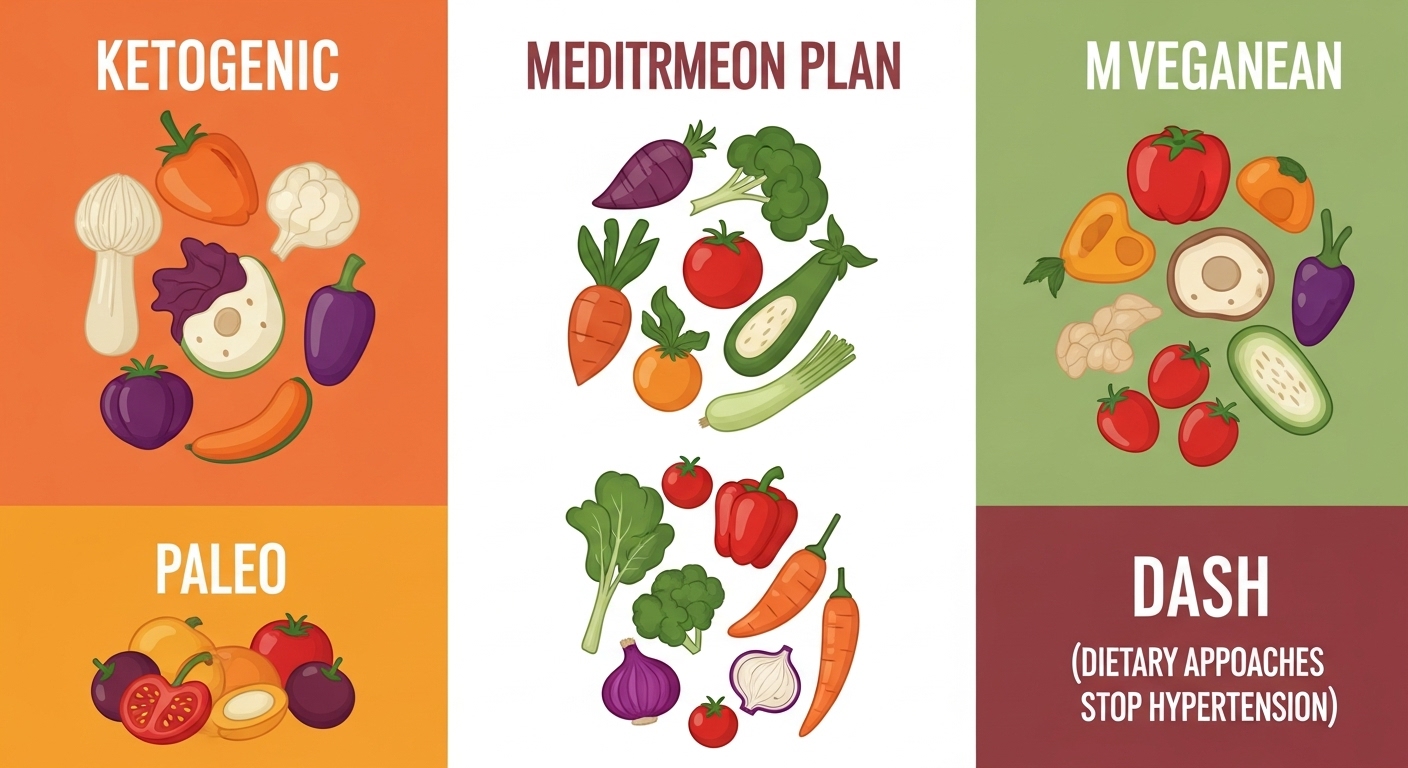
Nutrition plans vary based on individual goals, health conditions, and dietary preferences. Here are some common types:
-
Weight Loss Plans
Focus on creating a calorie deficit to reduce body fat.
Emphasize whole foods, portion control, and balanced macros.
May include intermittent fasting or low-carb approaches.
-
Muscle Gain Plans
Aim for a calorie surplus with higher protein intake.
Support muscle repair and growth with strength training.
Often include frequent meals and nutrient timing strategies.
-
Maintenance Plans
Designed to maintain current weight and health status.
Balanced calorie intake aligned with activity level.
Encourage sustainable, long-term healthy eating habits.
-
Specialized Plans for Medical Conditions
Tailored to manage or improve specific health issues such as:
• Diabetes (focus on blood sugar control)
• Heart disease (low saturated fat, high fiber)
• Hypertension (low sodium)
• Food allergies or intolerances (gluten-free, lactose-free)
-
Plant-Based and Vegetarian Plans
Emphasize fruits, vegetables, legumes, nuts, and grains.
Provide adequate protein and micronutrients through plant sources.
May exclude all animal products (vegan) or include dairy/eggs (vegetarian).
-
Performance and Athletic Plans
Customized to support endurance, strength, or recovery.
Often higher in carbohydrates and proteins.
Include hydration and supplementation strategies.
-
Detox and Cleanse Plans
Short-term plans aimed at eliminating toxins.
Emphasize whole, unprocessed foods, plenty of water, and often exclude processed foods and caffeine.
Weight Loss Plans

Weight loss plans are designed to help individuals reduce body fat by creating a calorie deficit, meaning you consume fewer calories than your body burns. These plans focus not only on reducing calories but also on maintaining balanced nutrition to ensure the body stays healthy during the process.
Key Principles of Weight Loss Plans
- Caloric Deficit: The foundation of weight loss is eating fewer calories than your Total Daily Energy Expenditure (TDEE).
- Balanced Macronutrients: Ensure adequate protein to preserve muscle mass, moderate carbohydrates for energy, and healthy fats for hormone balance.
- Nutrient-Dense Foods: Prioritize whole foods rich in vitamins, minerals, and fiber to support metabolism and satiety.
- Portion Control: Manage portion sizes to avoid overeating while still feeling satisfied.
- Hydration: Drink plenty of water to aid metabolism and reduce hunger.
- Meal Timing: Regular meals or planned intermittent fasting can help manage hunger and improve adherence.
Common Approaches in Weight Loss Plans
- Low-Calorie Diet: Reducing daily calorie intake safely by 300–500 calories.
- Low-Carbohydrate Diet: Limiting carb intake to promote fat burning.
- Intermittent Fasting: Eating during specific time windows to control calorie intake.
- High-Protein Diet: Increasing protein helps with satiety and muscle retention.
Sample Foods to Include
- Lean proteins: chicken breast, fish, tofu
- Vegetables: leafy greens, broccoli, peppers
- Whole grains: brown rice, quinoa, oats
- Healthy fats: avocado, nuts, olive oil
- Fruits: berries, apples, oranges (in moderation)
Benefits of a Well-Structured Weight Loss Plan
- Sustainable and healthy fat loss
- Improved energy and mood
- Better blood sugar and cholesterol levels
- Reduced risk of chronic diseases
Muscle Gain Plans
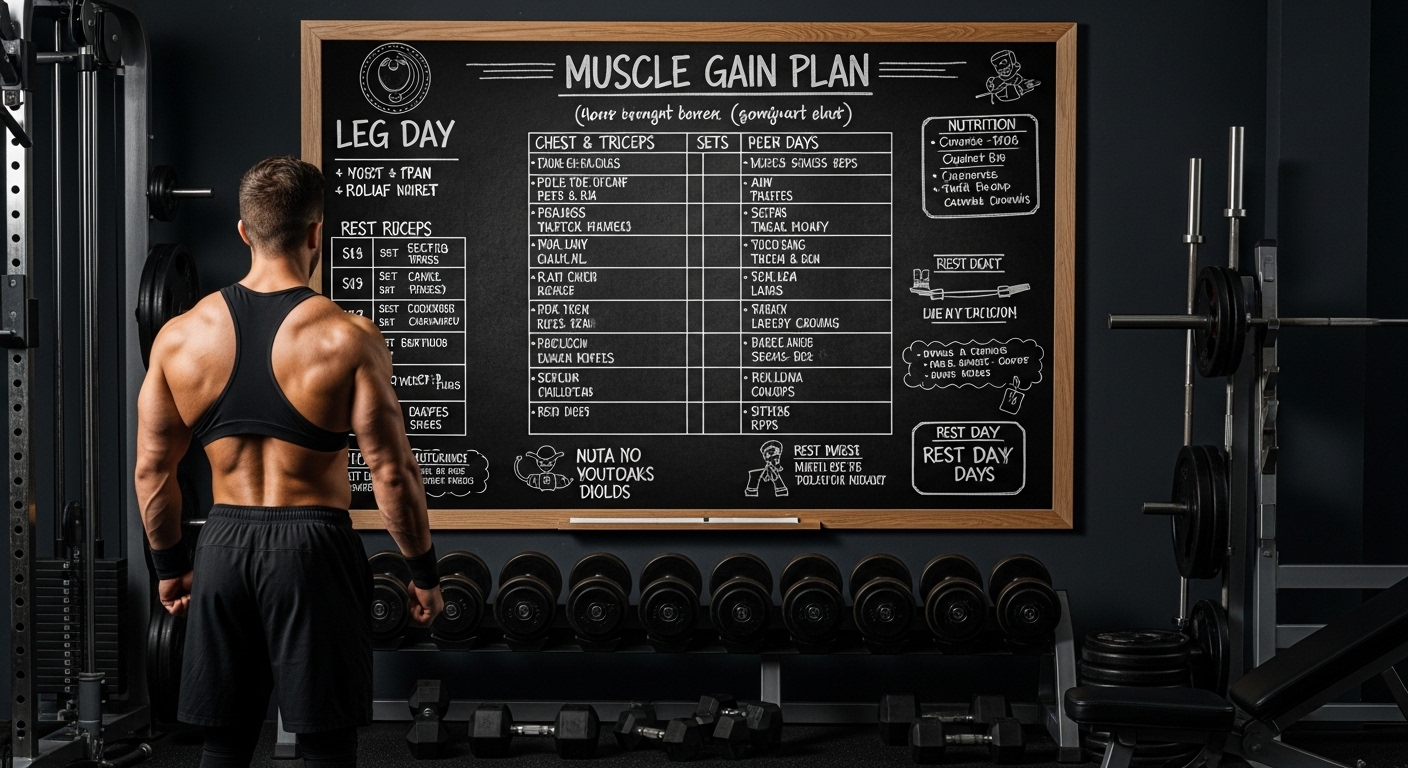
Muscle gain plans are designed to help individuals increase muscle mass by supporting muscle repair and growth through adequate nutrition and training. These plans typically focus on a caloric surplus, meaning consuming more calories than the body burns, combined with sufficient protein intake and strength training.
Key Principles of Muscle Gain Plans
- Caloric Surplus: Consuming 250–500 extra calories per day to fuel muscle growth without excessive fat gain.
- High Protein Intake: Essential for repairing and building muscle tissue. Recommended intake ranges from 1.2 to 2.2 grams of protein per kilogram of body weight.
- Balanced Carbohydrates: Carbs provide energy for workouts and replenish glycogen stores, aiding recovery.
- Healthy Fats: Support hormone production and overall health.
- Frequent Meals: Eating 4–6 meals per day helps provide a steady supply of nutrients and supports muscle synthesis.
- Hydration: Adequate water intake is crucial for muscle function and recovery.
Common Strategies in Muscle Gain Plans
- Protein Timing: Consuming protein evenly throughout the day, especially post-workout, to maximize muscle protein synthesis.
- Carb Loading Around Workouts: Eating carbs before and after exercise to optimize energy and recovery.
- Strength Training: Proper training is essential to stimulate muscle growth alongside nutrition.
Sample Foods to Include
- Lean meats: chicken, turkey, lean beef
- Fish and seafood: salmon, tuna
- Dairy: Greek yogurt, cottage cheese
- Plant-based proteins: legumes, tofu, tempeh
- Complex carbs: brown rice, oats, sweet potatoes
- Healthy fats: nuts, seeds, olive oil, avocado
Benefits of a Well-Structured Muscle Gain Plan
- Increased muscle size and strength
- Improved metabolism and body composition
- Enhanced athletic performance and recovery
- Better bone density and joint health
Maintenance Plans
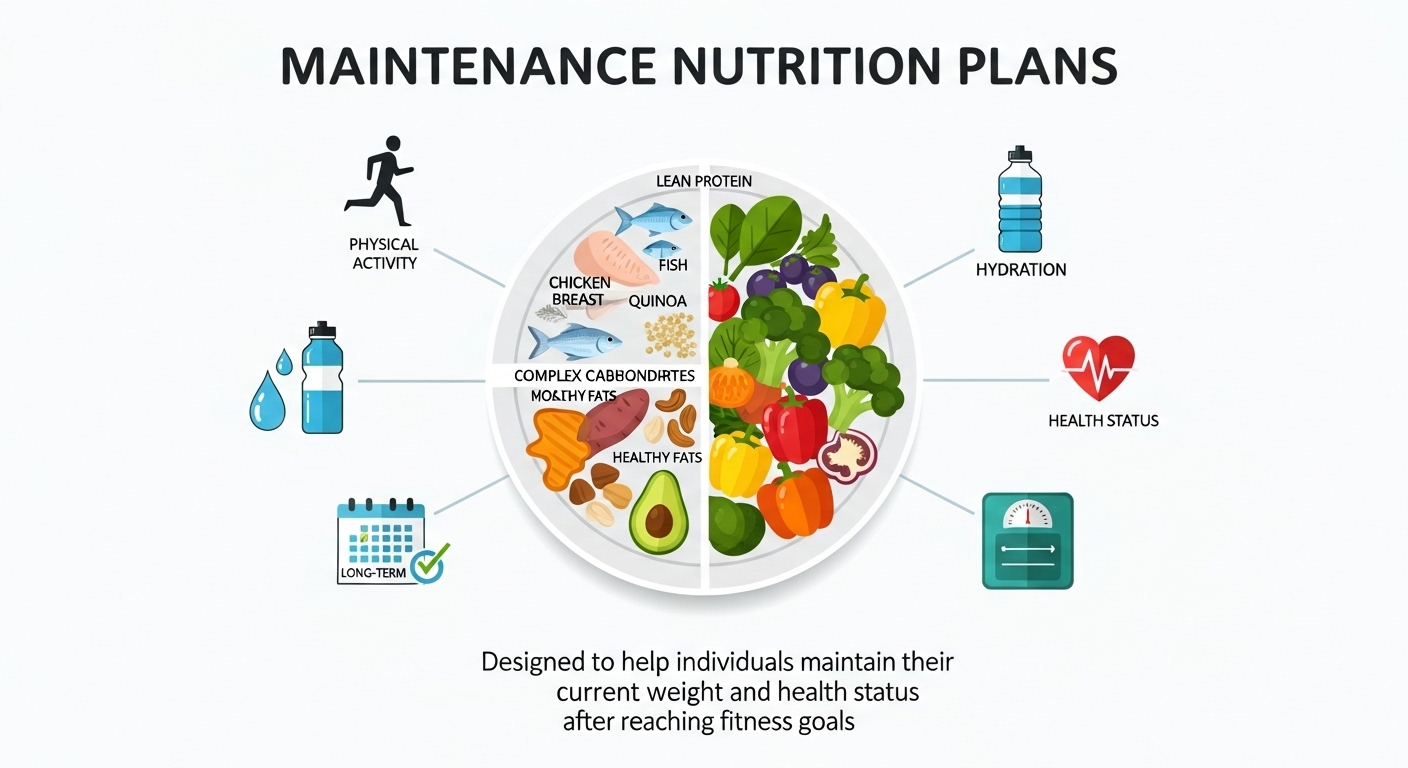
Maintenance nutrition plans are designed to help individuals maintain their current body weight and health status. After reaching a fitness or health goal—such as weight loss or muscle gain—the focus shifts to sustaining those results long-term through balanced eating habits and stable calorie intake.
Key Principles of Maintenance Plans
- Caloric Balance: Consume roughly the same number of calories as your Total Daily Energy Expenditure (TDEE) to keep weight steady.
- Balanced Macronutrients: Continue eating an appropriate mix of proteins, carbohydrates, and fats to support overall health and energy.
- Sustainable Habits: Focus on foods and meal patterns that can be maintained comfortably over time without feeling restrictive.
- Flexibility: Allow room for occasional treats and social meals to encourage a healthy relationship with food.
- Regular Physical Activity: Maintain consistent exercise to support metabolism and physical fitness.
Common Features of Maintenance Plans
- Emphasize whole, nutrient-dense foods to nourish the body.
- Encourage mindful eating and portion control.
- Support consistent hydration.
- Monitor weight and energy levels periodically to adjust intake if needed.
Benefits of a Maintenance Plan
- Prevents weight regain or unwanted weight loss.
- Supports continued physical performance and well-being.
- Promotes long-term health by preventing nutrient deficiencies.
- Encourages a balanced lifestyle without extreme dieting.
Specialized Nutrition Plans
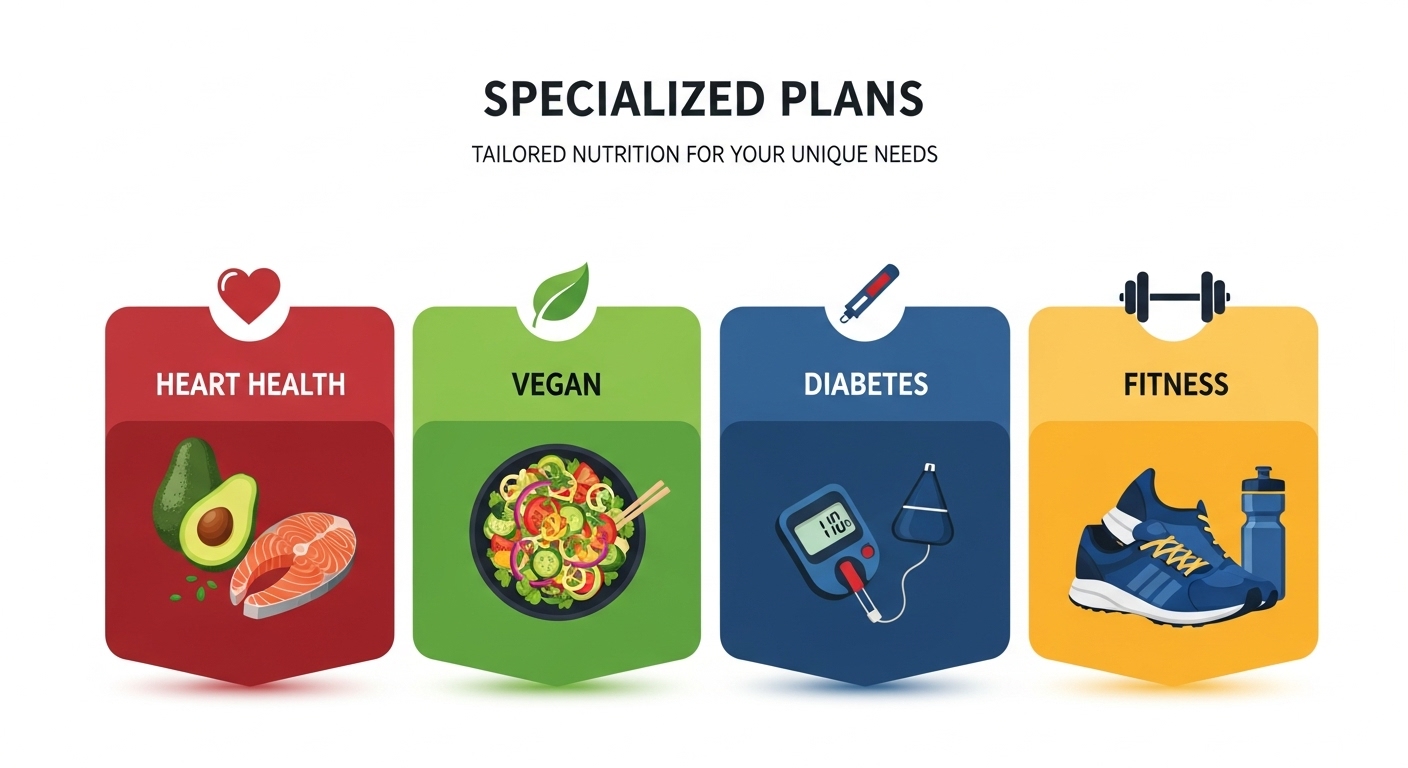
Specialized nutrition plans are designed to address particular health conditions, lifestyle choices, or dietary restrictions. These plans focus on managing symptoms, preventing complications, and promoting overall well-being by tailoring nutrient intake accordingly.
-
Diabetes-Friendly Plans
Goal: Regulate blood sugar levels and prevent spikes.
Key Features:
• Controlled carbohydrate intake with emphasis on complex carbs and fiber.
• Balanced meals with protein and healthy fats to slow glucose absorption.
• Limiting sugary foods and refined grains.
• Regular meal timing to maintain steady blood sugar.
Examples: Low glycemic index (GI) diets, carbohydrate counting.
-
Heart-Healthy Plans
Goal: Reduce risk factors for cardiovascular diseases.
Key Features:
• Low saturated and trans fats.
• High in fiber from fruits, vegetables, and whole grains.
• Moderate sodium intake to control blood pressure.
• Inclusion of healthy fats like omega-3 fatty acids from fish, flaxseeds, and walnuts.
Examples: DASH diet, Mediterranean diet.
-
Vegan and Vegetarian Plans
Goal: Meet nutritional needs without animal products (vegan) or excluding meat (vegetarian).
Key Features:
• Focus on plant-based protein sources like legumes, tofu, tempeh, nuts, and seeds.
• Attention to vitamin B12, iron, calcium, and omega-3 fatty acid intake, which may be low in these diets.
• Emphasis on whole grains, fruits, vegetables, and fortified foods.
• Considerations: May require supplementation or fortified foods for certain nutrients.
-
Other Specialized Plans
• Gluten-Free Plans: For those with celiac disease or gluten sensitivity, avoiding wheat, barley, and rye.
• Renal Diets: Manage kidney disease by controlling protein, sodium, potassium, and phosphorus intake.
• Allergy-Friendly Plans: Avoidance of specific allergens like nuts, dairy, or shellfish.
Benefits of Specialized Plans
- Help manage and improve chronic health conditions.
- Reduce symptoms and prevent complications.
- Ensure nutritional adequacy within dietary restrictions.
- Support overall quality of life.
How to Calculate Your Nutritional Needs
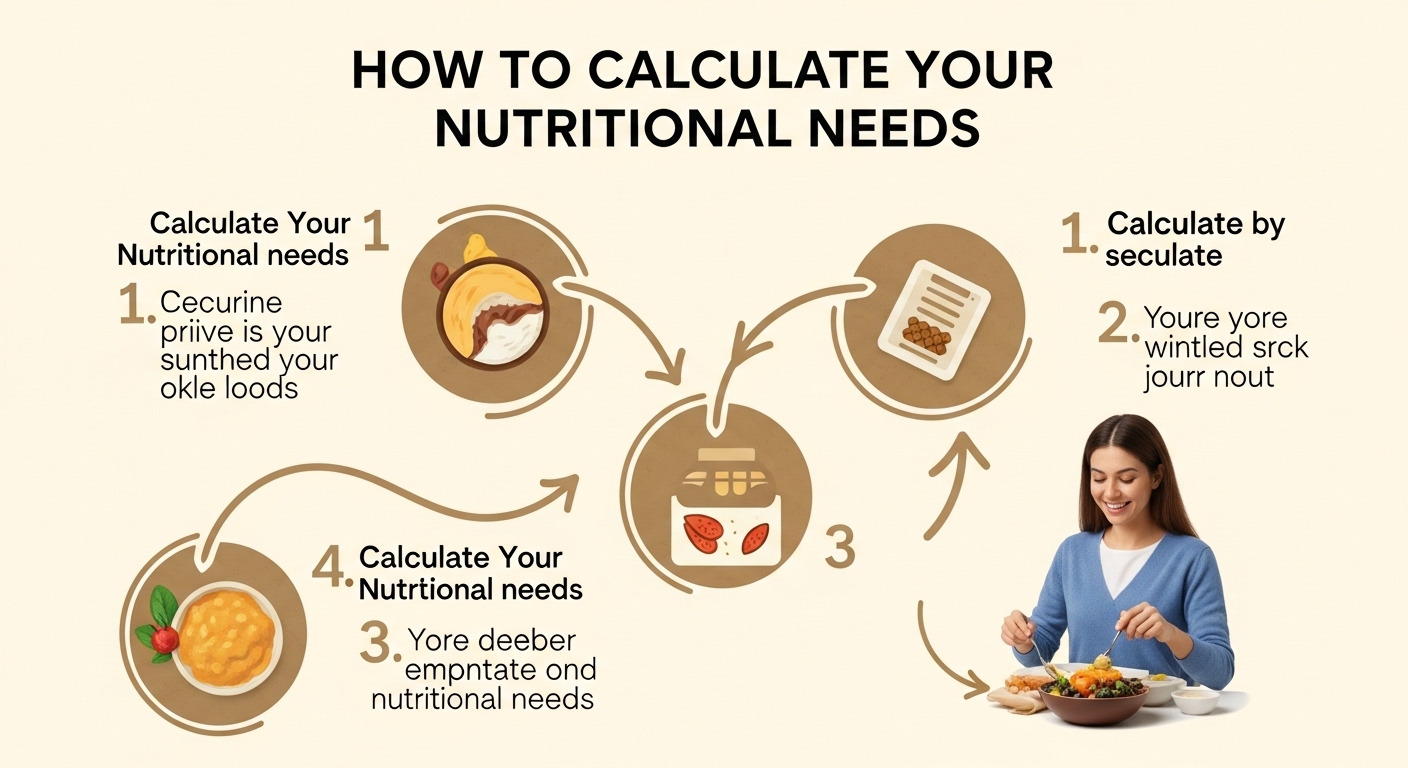
Calculating your nutritional needs is essential to create an effective nutrition plan tailored to your individual goals, body type, and lifestyle. It involves estimating the calories and nutrients your body requires daily for energy, growth, and maintenance.
Step 1: Calculate Your Basal Metabolic Rate (BMR)
BMR is the number of calories your body needs at rest to maintain vital functions (breathing, circulation, cell production). Use the Mifflin-St Jeor Equation:
- For men: BMR = 10 × weight (kg) + 6.25 × height (cm) – 5 × age + 5
- For women: BMR = 10 × weight (kg) + 6.25 × height (cm) – 5 × age – 161
Step 2: Calculate Your Total Daily Energy Expenditure (TDEE)
TDEE is the total calories you burn in a day, including activity and exercise. Multiply your BMR by an activity factor:
- Sedentary (little or no exercise): BMR × 1.2
- Lightly active (light exercise 1–3 days/week): BMR × 1.375
- Moderately active (moderate exercise 3–5 days/week): BMR × 1.55
- Very active (hard exercise 6–7 days/week): BMR × 1.725
- Extra active (very hard exercise & physical job): BMR × 1.9
Step 3: Adjust for Your Goals
- Weight Loss: Subtract 300–500 calories from your TDEE for a safe deficit.
- Muscle Gain: Add 250–500 calories to your TDEE for a surplus.
- Maintenance: Keep your calorie intake equal to your TDEE.
Step 4: Determine Macronutrient Needs
Based on total calories, allocate percentages to macronutrients:
- Proteins: 15–30% of total calories
- Carbohydrates: 45–65% of total calories
- Fats: 20–35% of total calories
Convert percentages to grams:
Protein & carbs = 4 calories per gram
Fat = 9 calories per gram
Example Calculation
A 30-year-old woman, 65 kg, 165 cm, moderately active:
- BMR = 10×65 + 6.25×165 – 5×30 – 161 = 1390 kcal
- TDEE = 1390 × 1.55 = 2155 kcal
- For weight loss (−500 kcal): 2155 – 500 = 1655 kcal/day
- Macronutrients (using 30% protein, 40% carbs, 30% fats):
- Protein: 0.3 × 1655 = 497 kcal ÷ 4 = 124 g
- Carbs: 0.4 × 1655 = 662 kcal ÷ 4 = 166 g
- Fats: 0.3 × 1655 = 497 kcal ÷ 9 = 55 g
Total Daily Energy Expenditure (TDEE)
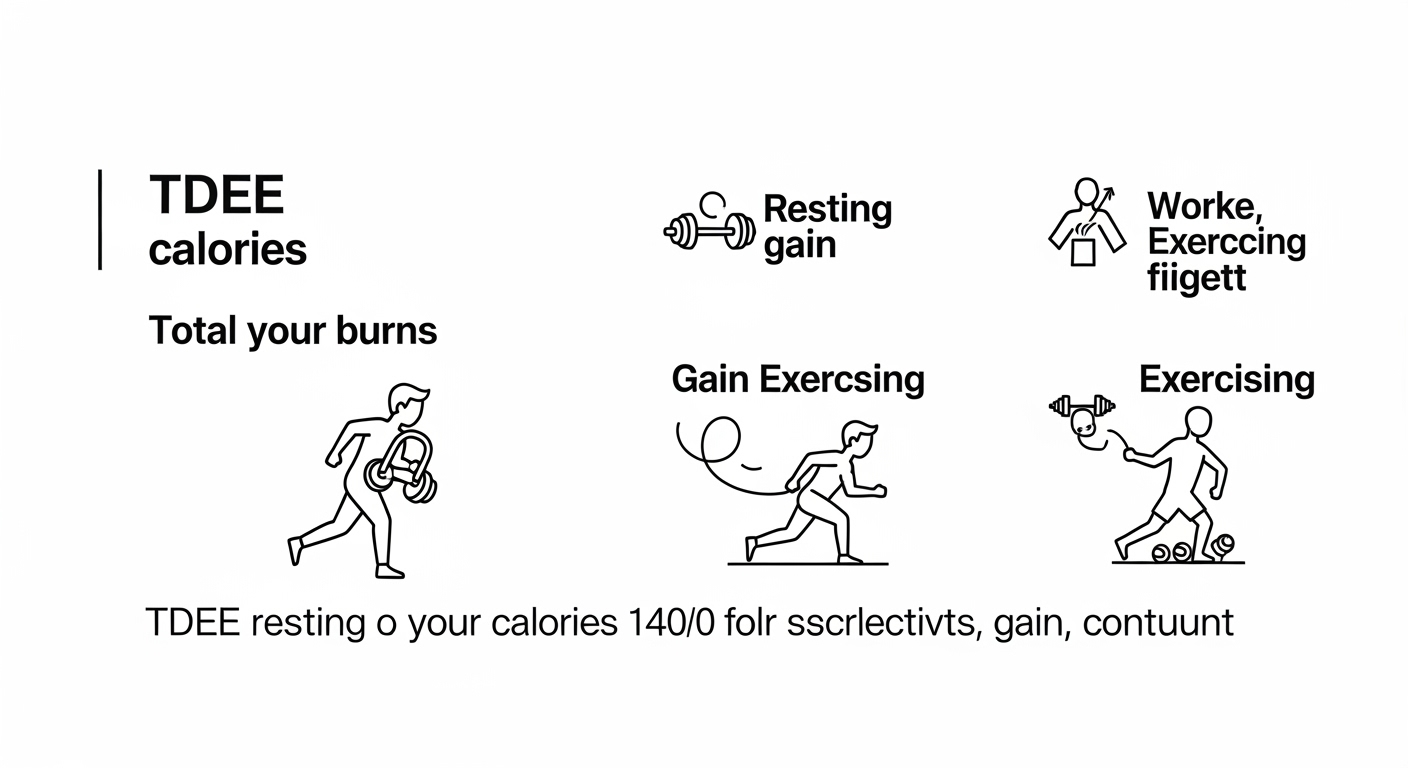
Total Daily Energy Expenditure (TDEE) represents the total number of calories your body burns in a day, including all activities such as resting, working, exercising, and even minor movements like fidgeting. It’s an essential value for determining how many calories you should consume to lose, gain, or maintain weight.
Components of TDEE
- Basal Metabolic Rate (BMR): Calories burned at rest for vital body functions (~60–75% of TDEE).
- Thermic Effect of Food (TEF): Energy used to digest and process food (~10%).
- Non-Exercise Activity Thermogenesis (NEAT): Calories burned through daily activities like walking or chores.
- Exercise Activity Thermogenesis (EAT): Calories burned during planned physical exercise.
How to Calculate TDEE
First, calculate your BMR (using the Mifflin-St Jeor formula), then multiply it by an activity factor:
- Sedentary (little or no exercise): BMR × 1.2
- Lightly active (light exercise 1–3 days/week): BMR × 1.375
- Moderately active (moderate exercise 3–5 days/week): BMR × 1.55
- Very active (hard exercise 6–7 days/week): BMR × 1.725
- Extra active (intense training & physical job): BMR × 1.9
Example
BMR = 1370 kcal (from previous calculation)
TDEE = 1370 × 1.55 = 2124 kcal/day
This means she needs about 2124 calories/day to maintain her current weight.
Using TDEE for Goals
- Weight Loss: TDEE – 300 to 500 kcal/day (moderate deficit).
- Muscle Gain: TDEE + 250 to 500 kcal/day (caloric surplus).
- Maintenance: Equal to TDEE.
Setting Calorie Goals
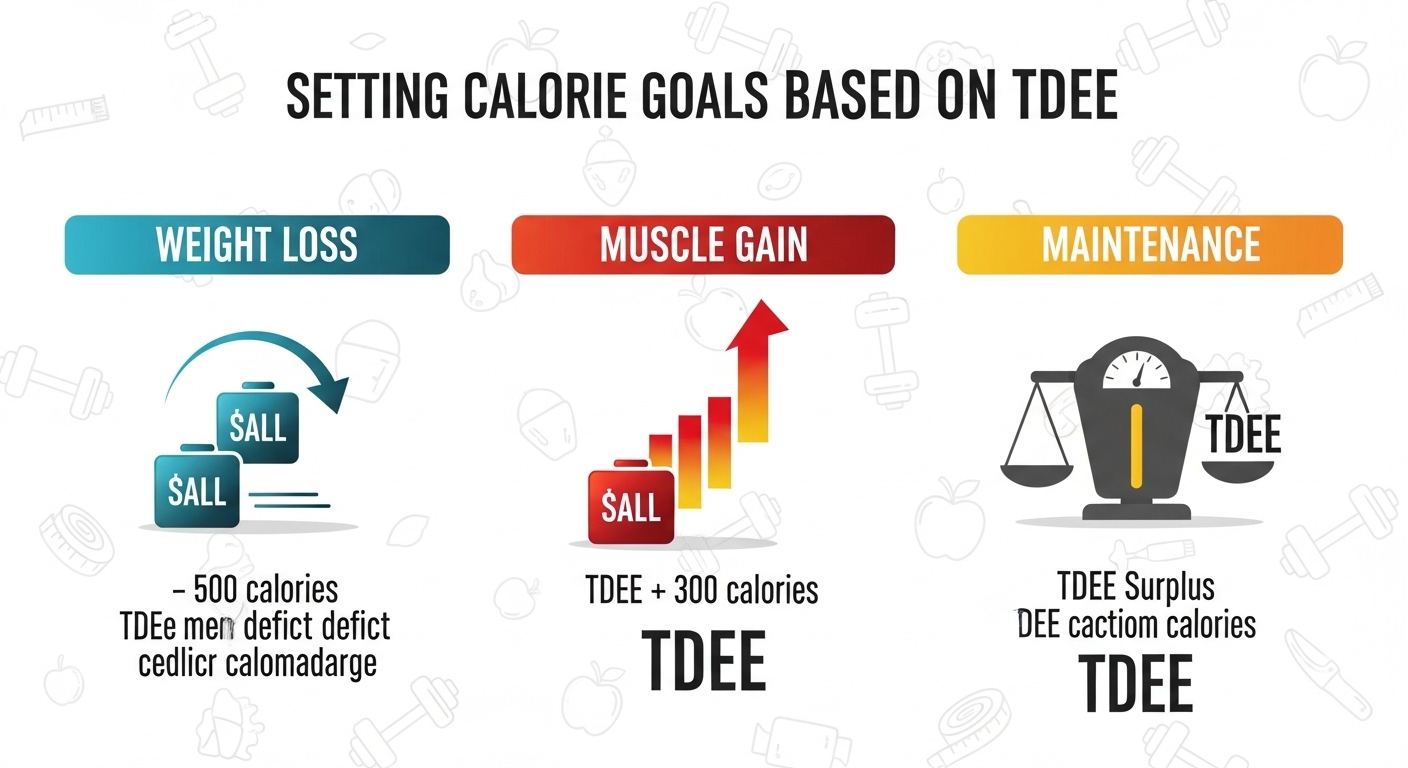
Once you know your TDEE (Total Daily Energy Expenditure), the next step is to set calorie targets that align with your health and fitness goals—whether that’s weight loss, muscle gain, or maintenance.
Step 1: Start with TDEE
Your TDEE represents the calories needed to maintain your current weight based on activity level. All calorie goals are based on this value.
Step 2: Choose Your Goal
- Weight Loss: Create a caloric deficit of 300–500 calories/day for gradual, sustainable fat loss (0.5–1 kg per week).
Example: If TDEE = 2200 kcal, weight loss goal = 1700–1900 kcal/day.
- Muscle Gain: Add 250–500 calories/day to your TDEE for a controlled surplus to build muscle without excessive fat gain.
Example: If TDEE = 2200 kcal, gain goal = 2450–2700 kcal/day.
- Maintenance: Keep intake equal to TDEE to maintain current weight.
Step 3: Distribute Macronutrients
Based on your calorie goal, allocate:
- Proteins: 15–30% of total calories (1.2–2.2 g per kg of body weight).
- Carbohydrates: 45–65% of total calories (higher for active individuals).
- Fats: 20–35% of total calories.
Conversions:
1 g protein = 4 kcal | 1 g carbohydrate = 4 kcal | 1 g fat = 9 kcal
Example: Weight Loss Goal
TDEE = 2200 kcal, target = 1800 kcal/day
Macros (30% protein, 40% carbs, 30% fat):
Protein: 0.3 × 1800 = 540 kcal ÷ 4 = 135 g
Carbs: 0.4 × 1800 = 720 kcal ÷ 4 = 180 g
Fats: 0.3 × 1800 = 540 kcal ÷ 9 = 60 g
Tips for Setting Calorie Goals
- Avoid extreme deficits (>750 kcal/day) to prevent muscle loss and fatigue.
- Recalculate goals every 4–6 weeks as weight and activity change.
- Focus on nutrient-dense foods to meet vitamin and mineral needs.
Macronutrient Ratios Explained
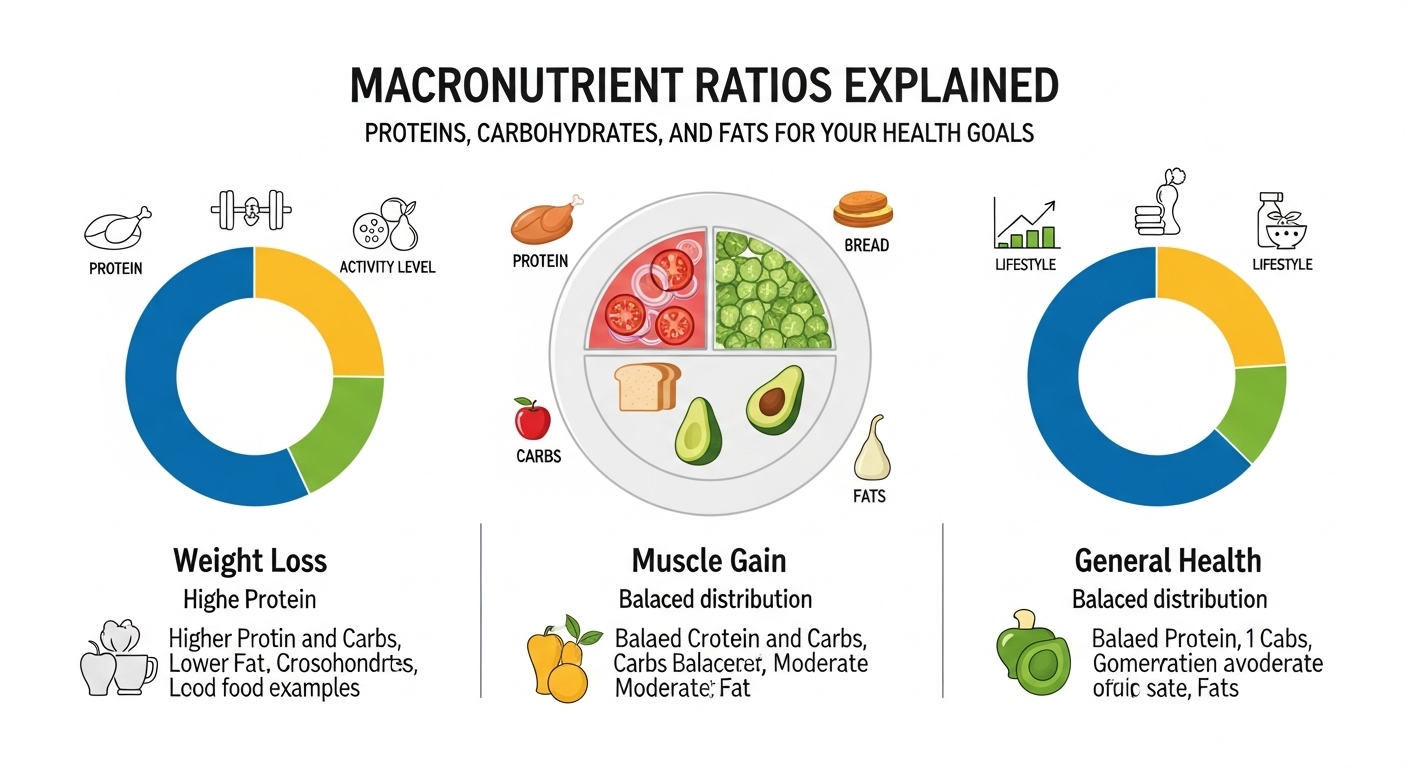
Macronutrients — proteins, carbohydrates, and fats — provide the calories and energy your body needs. The right ratio of these macronutrients depends on your health goals, activity level, and lifestyle. Understanding these ratios helps you plan balanced meals that support your objectives.
Standard Macronutrient Distribution Range (AMDR)
- Proteins: 15–30% of total calories
- Carbohydrates: 45–65% of total calories
- Fats: 20–35% of total calories
These ranges are recommended by health authorities to ensure adequate nutrient intake and energy balance.
Why Ratios Matter
- Proteins: Build and repair muscles, support immune health, maintain satiety.
- Carbohydrates: Primary energy source for the brain and muscles.
- Fats: Support hormone production, nutrient absorption, and long-term energy.
Macronutrient Ratios for Different Goals
- Weight Loss: Higher protein for satiety and muscle preservation.
Example: 30% protein, 40% carbs, 30% fats
- Muscle Gain: More carbs and moderate fats to fuel workouts and recovery.
Example: 25% protein, 50% carbs, 25% fats
- Maintenance: Balanced distribution for overall health.
Example: 20% protein, 50% carbs, 30% fats
How to Calculate in Grams
Start with daily calorie target (e.g., 2000 kcal)
Apply the ratio:
Protein: 25% → 500 kcal ÷ 4 = 125 g
Carbs: 50% → 1000 kcal ÷ 4 = 250 g
Fats: 25% → 500 kcal ÷ 9 = 55 g
Tips for Success
- Use food tracking apps to monitor intake.
- Adjust ratios based on results and how your body feels.
- Focus on quality: lean proteins, whole carbs, healthy fats.
Protein Requirements
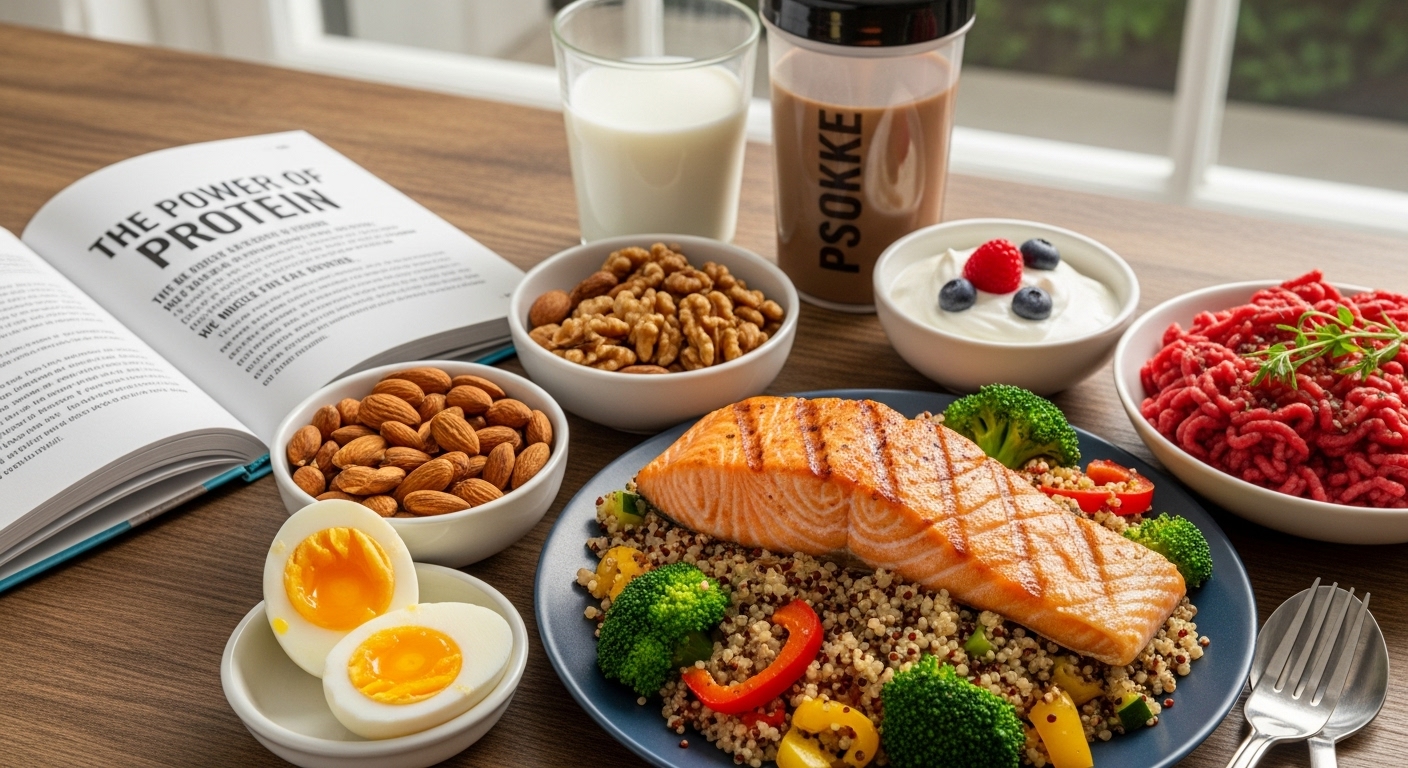
Protein is a crucial macronutrient for building and repairing tissues, supporting muscle growth, hormone production, and overall health. Adequate protein intake is especially important for athletes, active individuals, and anyone pursuing weight loss or muscle gain.
Why Protein is Important
- Builds and repairs muscles and tissues.
- Helps in enzyme and hormone production.
- Provides satiety, reducing overeating.
- Maintains muscle mass during weight loss.
General Protein Guidelines
- Sedentary Adults: ~0.8 g per kg of body weight/day
- Active Adults: 1.2–2.0 g per kg of body weight/day
- Athletes/Strength Training: 1.6–2.2 g per kg of body weight/day
- Weight Loss (Preserve Muscle): 1.6–2.4 g per kg of body weight/day
Example Calculation
Person: 70 kg (moderately active, building muscle)
Recommendation: 1.8 g/kg
Protein Requirement: 70 × 1.8 = 126 g/day
Protein Distribution
Spread protein intake across meals for optimal muscle protein synthesis.
Example: 3 meals + 2 snacks → ~25–35 g protein per meal.
Best Sources of Protein
- Animal-Based: Chicken, turkey, lean beef, fish, eggs, dairy (Greek yogurt, cottage cheese)
- Plant-Based: Lentils, beans, tofu, tempeh, quinoa, edamame, nuts, seeds
Tips to Meet Protein Goals
- Include a protein source in every meal.
- Use protein shakes or powders if whole food intake is insufficient.
- Combine plant-based sources for complete amino acid profiles.
Carbohydrate Requirements
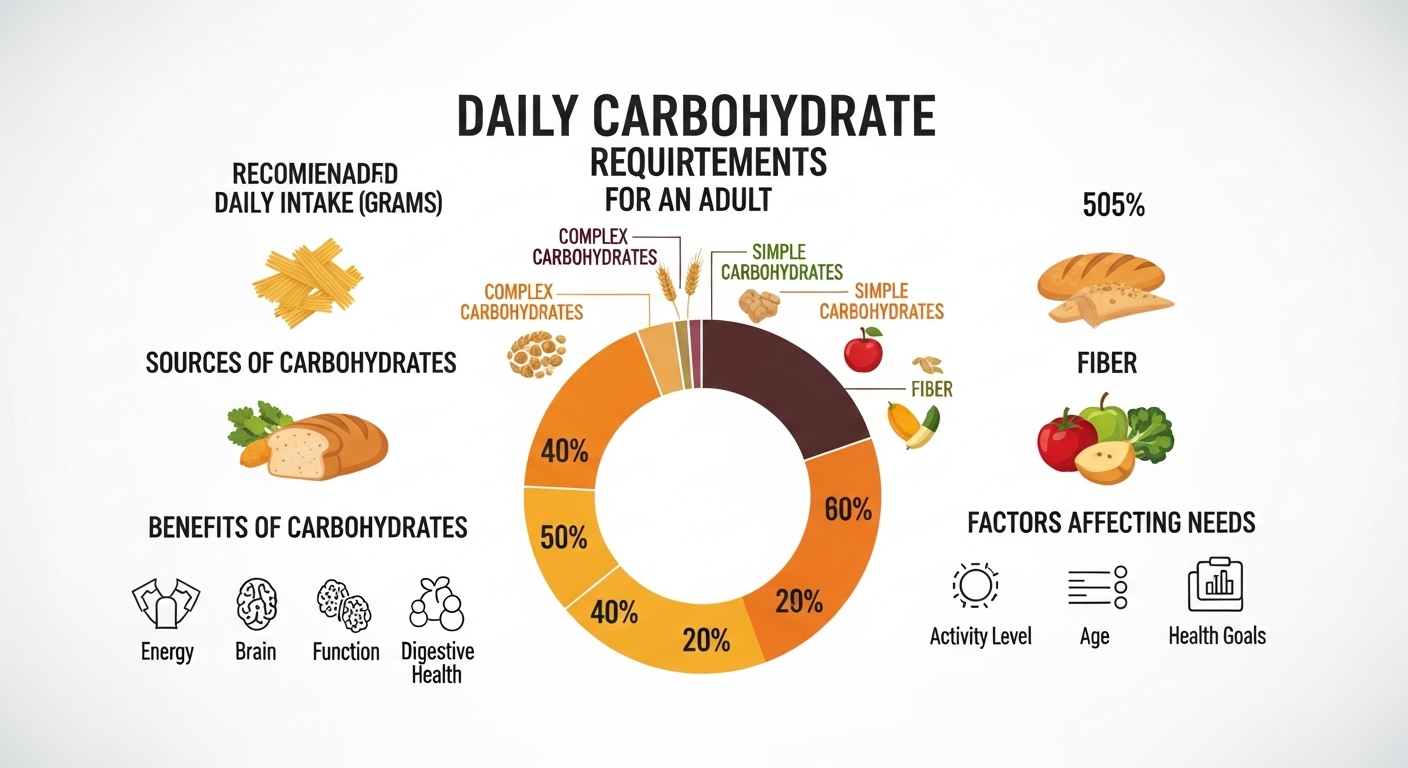
Carbohydrates are the body’s primary source of energy, fueling the brain, muscles, and organs. They are especially important for those engaged in physical activity, as they replenish glycogen stores and maintain energy levels.
Why Carbohydrates Are Important
- Provide quick and sustained energy for daily activities and workouts.
- Essential for proper brain function (the brain relies on glucose).
- Aid in recovery by restoring glycogen after exercise.
- Supply fiber, vitamins, and minerals when sourced from whole foods.
General Carbohydrate Guidelines
- General Health: 45–65% of total daily calories from carbs.
- Active Adults: 3–5 g per kg of body weight/day.
- Endurance Athletes: 6–10 g per kg of body weight/day.
- Weight Loss: Lower range (40–45%) with a focus on complex carbs.
Example Calculation
Person: 70 kg (moderately active), calorie intake = 2200 kcal
Carbs = 50% of calories → 1100 kcal ÷ 4 = 275 g/day
Types of Carbohydrates
- Complex Carbs (Preferred): Whole grains, oats, brown rice, quinoa, legumes, vegetables.
Benefit: Provide fiber, steady energy, and nutrients.
- Simple Carbs (Limit Intake): Sugary snacks, white bread, soda.
Issue: Cause rapid spikes and crashes in blood sugar.
Tips for Healthy Carbohydrate Intake
- Prioritize fiber-rich carbs (whole grains, vegetables, fruits).
- Pair carbs with protein and healthy fats to stabilize blood sugar.
- Avoid refined sugars and processed foods.
- Use carb timing: more before/after workouts for energy and recovery.
Fat Requirements
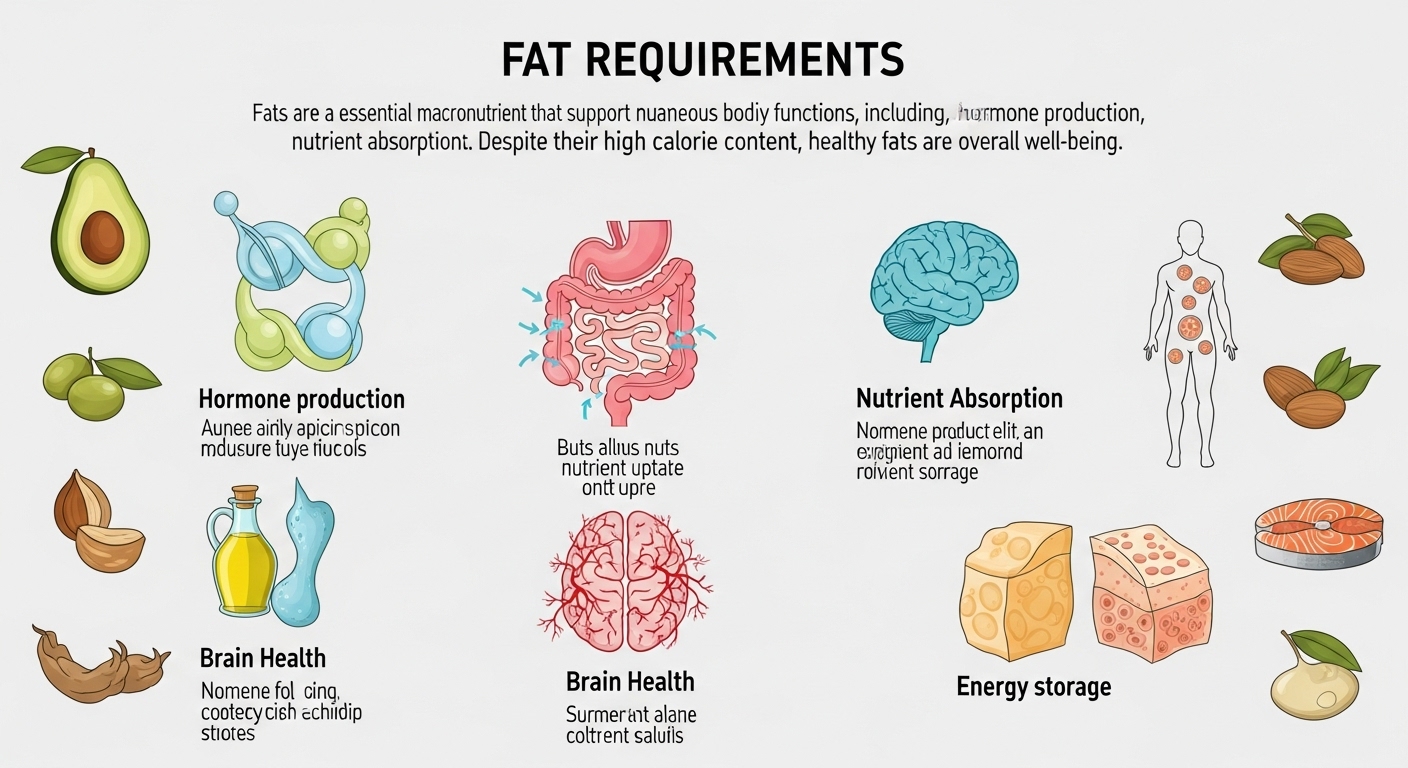
Fats are an essential macronutrient that support numerous bodily functions, including hormone production, nutrient absorption, brain health, and energy storage. Despite their high calorie content, healthy fats are crucial for overall well-being.
Why Fats Are Important
- Provide long-term energy (1 g fat = 9 kcal).
- Help absorb fat-soluble vitamins (A, D, E, K).
- Support hormone regulation and brain function.
- Protect organs and maintain healthy skin and hair.
Recommended Fat Intake
20–35% of total daily calories should come from fat.
For a 2000 kcal diet:
20% = 400 kcal ÷ 9 = 44 g
35% = 700 kcal ÷ 9 = 78 g
Types of Fats
- Healthy Fats (Include More):
Monounsaturated: Olive oil, avocado, nuts.
Polyunsaturated: Fatty fish (salmon, tuna), walnuts, flaxseeds, chia seeds.
Omega-3 Fatty Acids: Essential for heart and brain health.
- Limit These:
Saturated Fats: Butter, full-fat dairy, fatty meats.
Avoid: Trans Fats found in processed snacks, fried foods, margarine.
Example Calculation
For a 2200 kcal diet, 30% from fat:
2200 × 0.30 = 660 kcal ÷ 9 = 73 g fat/day
Tips for Healthy Fat Consumption
- Use healthy oils like olive or avocado oil instead of butter.
- Add nuts and seeds to snacks or salads.
- Eat fatty fish at least 2 times per week for omega-3s.
- Avoid fried and highly processed foods.
Sample Nutrition Plans
A well-designed nutrition plan includes balanced macronutrients, micronutrients, proper hydration, and meal timing. Below are sample plans for different goals:
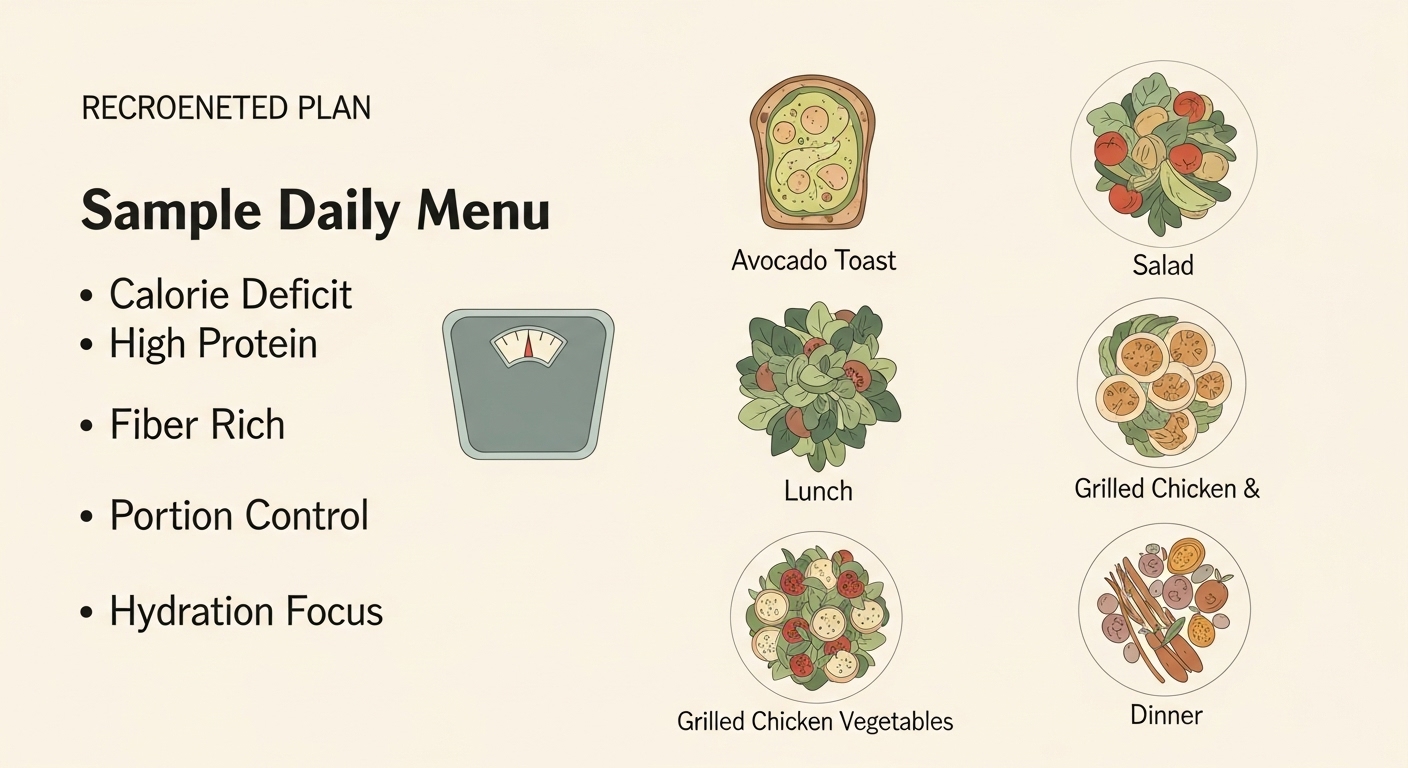
1. Weight Loss Plan (Approx. 1500–1700 kcal)
- Breakfast: 2 boiled eggs + 1 slice whole-grain toast, 1 cup green tea
- Snack: Greek yogurt (unsweetened) + 1 tbsp chia seeds
- Lunch: Grilled chicken breast (120 g), Steamed vegetables + ½ cup quinoa
- Snack: Apple + 10 almonds
- Dinner: Grilled fish (100 g), Green salad with olive oil & lemon dressing
Macros: High protein, moderate carbs, moderate fat.
2. Muscle Gain Plan (Approx. 2500–2800 kcal)
- Breakfast: 4 scrambled eggs + 2 slices whole-grain toast, 1 banana + 1 glass milk
- Snack: Protein shake + handful of nuts
- Lunch: Brown rice (1 cup), Grilled chicken (150 g), Steamed vegetables
- Snack: Cottage cheese + fruit
- Dinner: Salmon (150 g), Sweet potato (1 medium), Mixed salad with avocado
Macros: High protein, higher carbs, moderate fat.
3. Maintenance Plan (Approx. 2000–2200 kcal)
- Breakfast: Oatmeal with berries & peanut butter, 1 boiled egg
- Snack: Handful of mixed nuts + fruit
- Lunch: Brown rice (¾ cup), Grilled turkey (120 g), Vegetables sautéed in olive oil
- Snack: Greek yogurt + honey drizzle
- Dinner: Grilled fish or tofu, Quinoa or whole-grain pasta, Salad with olive oil dressing
4. Specialized Plan – Diabetes-Friendly (Approx. 1800 kcal)
- Breakfast: Vegetable omelet (egg whites + veggies), 1 small whole-wheat chapati
- Snack: Handful of walnuts
- Lunch: Grilled chicken or paneer, Brown rice (½ cup) + green leafy vegetables
- Snack: Cucumber + hummus
- Dinner: Fish curry or tofu curry, Mixed vegetables sautéed in olive oil
Tips for All Plans
- Drink 2–3 liters of water daily.
- Adjust portion sizes according to your TDEE and goals.
- Include variety to cover micronutrient needs.
Balanced 2000-Calorie Plan
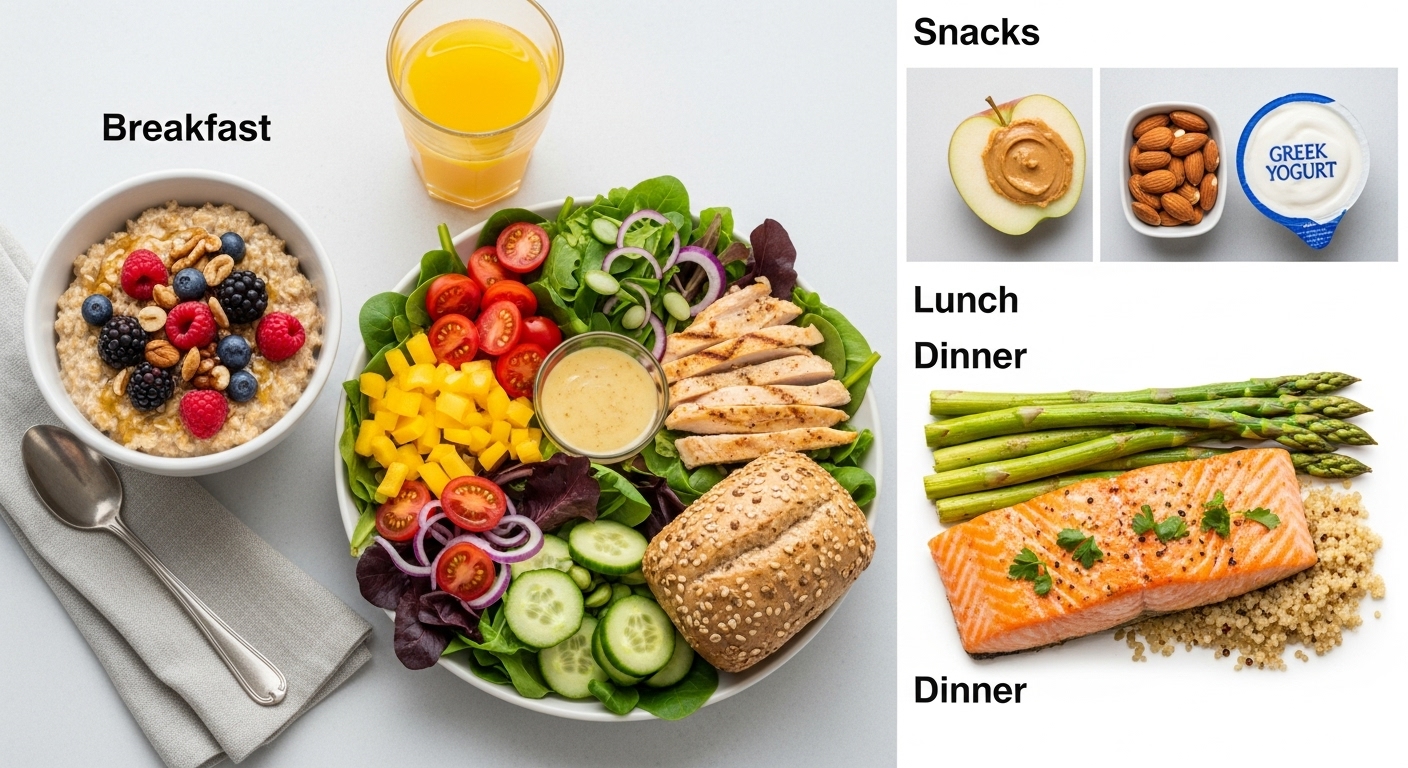
Macro Breakdown (Approx.):
- Protein: 20% (100 g)
- Carbohydrates: 50% (250 g)
- Fats: 30% (67 g)
✅ Breakfast (≈500 kcal)
½ cup oats cooked with 1 cup skim milk
1 tbsp peanut butter
1 medium banana
1 tsp chia seeds
Macros: 12 g protein | 70 g carbs | 12 g fat
✅ Morning Snack (≈200 kcal)
1 small apple
10 almonds
Macros: 3 g protein | 22 g carbs | 9 g fat
✅ Lunch (≈600 kcal)
1 cup brown rice
150 g grilled chicken breast (or tofu for veg)
1 cup steamed broccoli & carrots
1 tsp olive oil drizzle
Macros: 38 g protein | 65 g carbs | 12 g fat
✅ Afternoon Snack (≈200 kcal)
1 cup Greek yogurt (unsweetened)
½ cup berries
Macros: 12 g protein | 15 g carbs | 3 g fat
✅ Dinner (≈500 kcal)
120 g baked salmon (or paneer for veg)
1 medium sweet potato
1 cup green salad with olive oil & lemon dressing
Macros: 35 g protein | 45 g carbs | 15 g fat
💧 Hydration
8–10 glasses (≈2.5 liters) water per day.
✅ Nutritional Highlights
- ✔ Balanced macros for sustained energy.
- ✔ Includes fiber from fruits, vegetables, and whole grains.
- ✔ Healthy fats from nuts, olive oil, and salmon.
- ✔ Suitable for general maintenance and active lifestyle.
Weight Loss Sample Plan
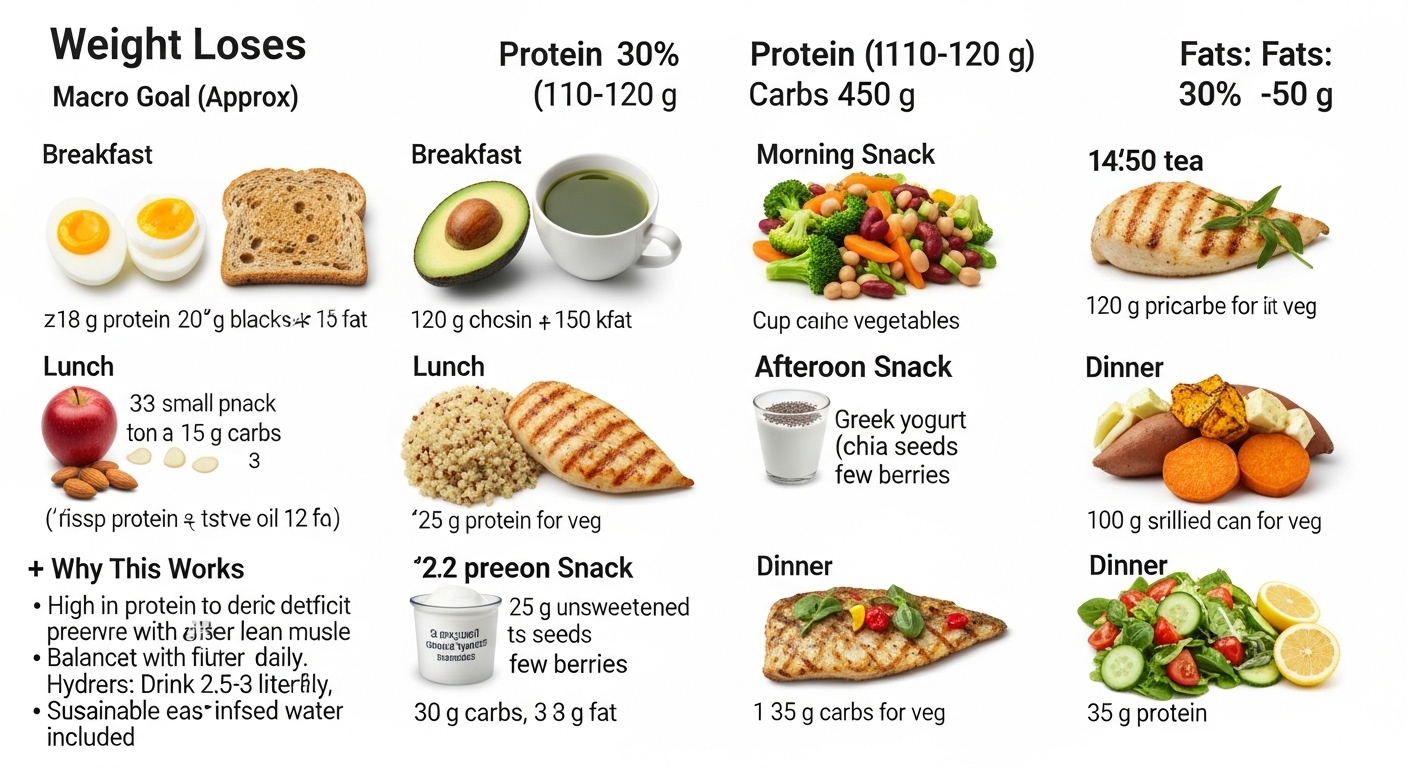
Macro Goal (Approx.):
- Protein: 30% (~110–120 g)
- Carbs: 40% (~150 g)
- Fats: 30% (~50 g)
✅ Breakfast (≈350 kcal)
2 boiled eggs (or 3 egg whites + 1 yolk)
1 slice whole-grain toast
½ avocado
1 cup green tea or black coffee
Macros: ~18 g protein | 20 g carbs | 15 g fat
✅ Morning Snack (≈150 kcal)
1 small apple
10 almonds
Macros: ~3 g protein | 15 g carbs | 8 g fat
✅ Lunch (≈450 kcal)
120 g grilled chicken breast (or tofu for veg)
½ cup quinoa or brown rice
1 cup steamed vegetables (broccoli, carrots, beans)
1 tsp olive oil drizzle
Macros: ~35 g protein | 35 g carbs | 12 g fat
✅ Afternoon Snack (≈150 kcal)
½ cup Greek yogurt (unsweetened)
1 tsp chia seeds
A few berries
Macros: ~8 g protein | 10 g carbs | 3 g fat
✅ Dinner (≈400 kcal)
100 g grilled fish (or paneer for veg)
1 small sweet potato
1 cup salad (greens, cucumber, tomato) with lemon dressing
Macros: ~30 g protein | 35 g carbs | 8 g fat
💧 Hydration
Drink 2.5–3 liters of water daily.
Herbal tea or infused water can be included.
✅ Why This Works
- ✔ Creates a caloric deficit without starving.
- ✔ High in protein to preserve lean muscle.
- ✔ Balanced with fiber-rich carbs and healthy fats for satiety.
- ✔ Sustainable and easy to follow.
Muscle Gain Sample Plan
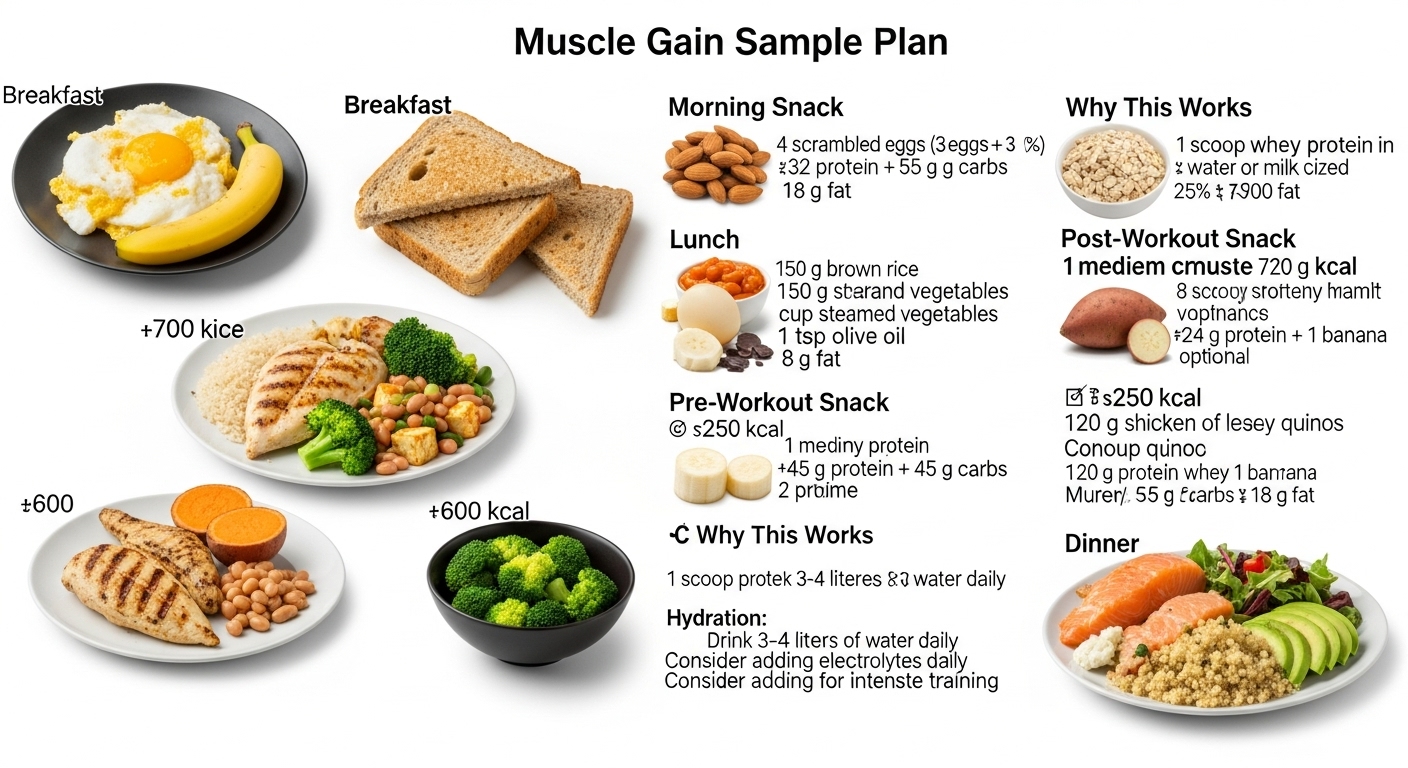
Macro Goal (Approx.):
- Protein: 25% (~150–170 g)
- Carbs: 50% (~320–350 g)
- Fats: 25% (~70–80 g)
✅ Breakfast (≈600 kcal)
4 scrambled eggs (or 3 eggs + 3 whites)
2 slices whole-grain toast
1 banana
1 tsp peanut butter
Macros: ~32 g protein | 55 g carbs | 18 g fat
✅ Morning Snack (≈300 kcal)
1 scoop whey protein in water or milk
10 almonds
½ cup oats (overnight soaked)
Macros: ~28 g protein | 25 g carbs | 8 g fat
✅ Lunch (≈700 kcal)
1 cup brown rice
150 g grilled chicken breast (or paneer for veg)
1 cup steamed vegetables (broccoli, beans)
1 tsp olive oil
Macros: ~40 g protein | 75 g carbs | 14 g fat
✅ Pre-Workout Snack (≈250 kcal)
1 medium sweet potato
1 boiled egg or small protein shake
Macros: ~8 g protein | 45 g carbs | 2 g fat
✅ Post-Workout Snack (≈250 kcal)
1 scoop whey protein + 1 banana
1 tsp honey (optional)
Macros: ~24 g protein | 30 g carbs | 1 g fat
✅ Dinner (≈600 kcal)
120 g salmon or chicken
1 cup quinoa
Mixed green salad with avocado slices
1 tsp olive oil
Macros: ~35 g protein | 55 g carbs | 18 g fat
💧 Hydration
Drink 3–4 liters of water daily.
Consider adding electrolytes for intense training.
✅ Why This Works
- ✔ Creates a controlled calorie surplus for lean muscle gain.
- ✔ High protein for muscle repair and growth.
- ✔ Complex carbs for energy and glycogen replenishment.
- ✔ Healthy fats for hormone production and recovery.
Vegan/Vegetarian Sample Plan
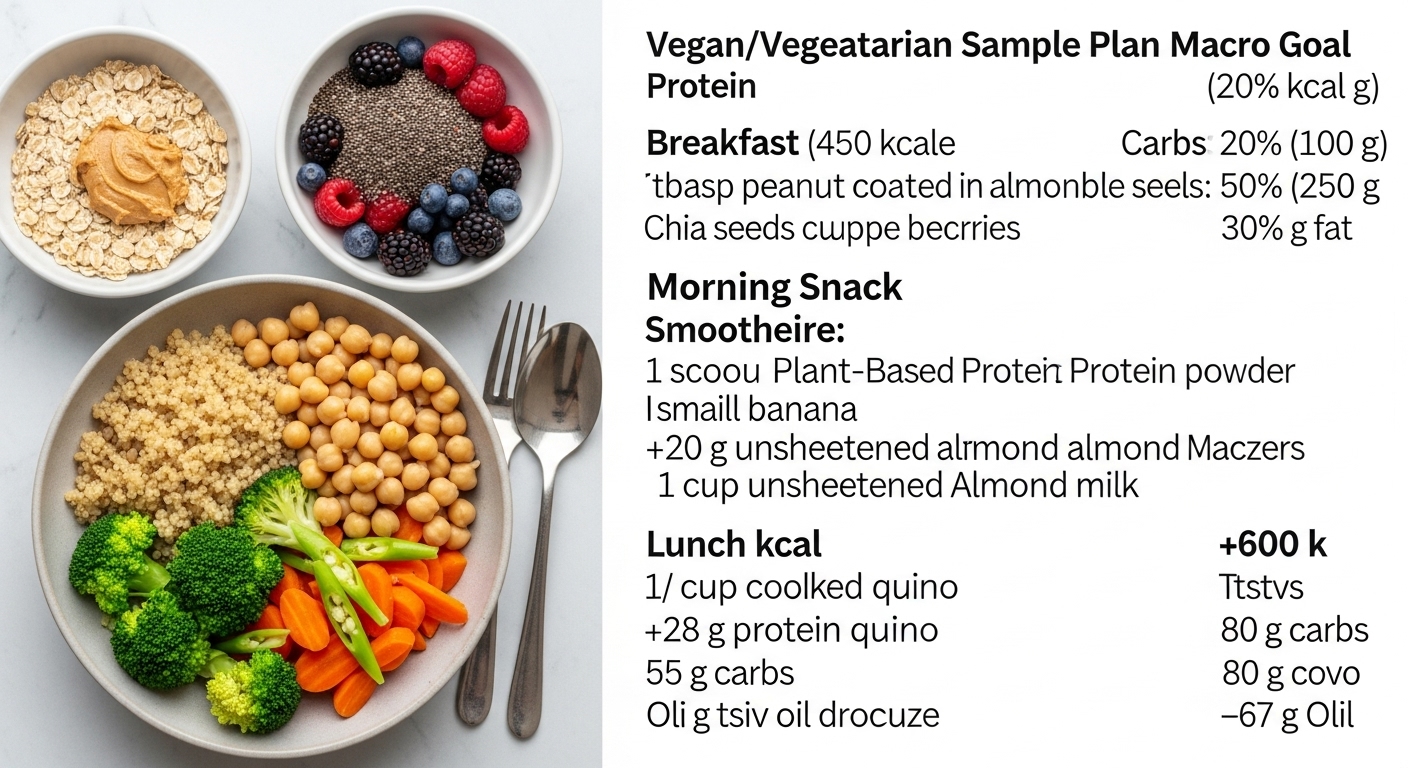
Macro Goal (Approx.):
- Protein: 20% (~100 g)
- Carbs: 50% (~250 g)
- Fats: 30% (~67 g)
✅ Breakfast (≈450 kcal)
½ cup rolled oats cooked in almond milk
1 tbsp peanut butter
1 tbsp chia seeds
½ cup berries
Macros: ~12 g protein | 55 g carbs | 16 g fat
✅ Morning Snack (≈200 kcal)
Smoothie:
1 scoop plant-based protein powder
1 small banana
1 cup unsweetened almond milk
Macros: ~20 g protein | 25 g carbs | 4 g fat
✅ Lunch (≈600 kcal)
1 cup cooked quinoa
1 cup chickpeas or lentils
1 cup steamed broccoli & carrots
1 tsp olive oil drizzle
Macros: ~28 g protein | 80 g carbs | 15 g fat
✅ Afternoon Snack (≈200 kcal)
10 almonds + 10 walnut halves
1 apple
Macros: ~6 g protein | 18 g carbs | 12 g fat
✅ Dinner (≈550 kcal)
120 g tofu stir-fry with vegetables
1 medium sweet potato
1 tsp olive oil
Macros: ~25 g protein | 50 g carbs | 14 g fat
✅ Why This Works
- ✔ Provides complete proteins by combining legumes, grains, and tofu.
- ✔ Includes fiber-rich carbs for sustained energy.
- ✔ Healthy fats from nuts, seeds, and olive oil.
- ✔ 100% plant-based and nutrient-dense.
Tips for Following a Nutrition Plan

Following a nutrition plan consistently is the key to achieving your health and fitness goals. Here are practical tips to stay on track:
- Plan Ahead: Prepare a weekly meal plan and grocery list. Cook in bulk for busy days to avoid relying on processed food.
- Track Your Intake: Use apps like MyFitnessPal or Cronometer to monitor calories and macros. Measure portion sizes until you can estimate accurately.
- Stay Flexible: It’s okay to include occasional treats in moderation. Focus on overall consistency rather than perfection.
- Prioritize Whole Foods: Choose natural, nutrient-dense foods (fruits, veggies, lean proteins, whole grains). Minimize processed, sugary, and fried foods.
- Hydrate Well: Drink 2–3 liters of water daily. Herbal teas and infused water can help you stay hydrated.
- Balance Your Plate: Fill ½ with vegetables, ¼ with protein, and ¼ with complex carbs. Include healthy fats in moderation.
- Don’t Skip Meals: Eat at regular intervals to maintain energy and metabolism. Include protein in each meal to stay full longer.
- Listen to Your Body: Adjust portion sizes based on hunger and activity level. Avoid extreme restrictions that lead to cravings and binge eating.
- Reassess Regularly: Review your progress every 4–6 weeks. Adjust calorie and macro targets if your weight or activity changes.
- Combine with Exercise & Sleep: Pair your plan with strength training + cardio for best results. Aim for 7–9 hours of quality sleep to support recovery and metabolism.
Meal Prep & Planning
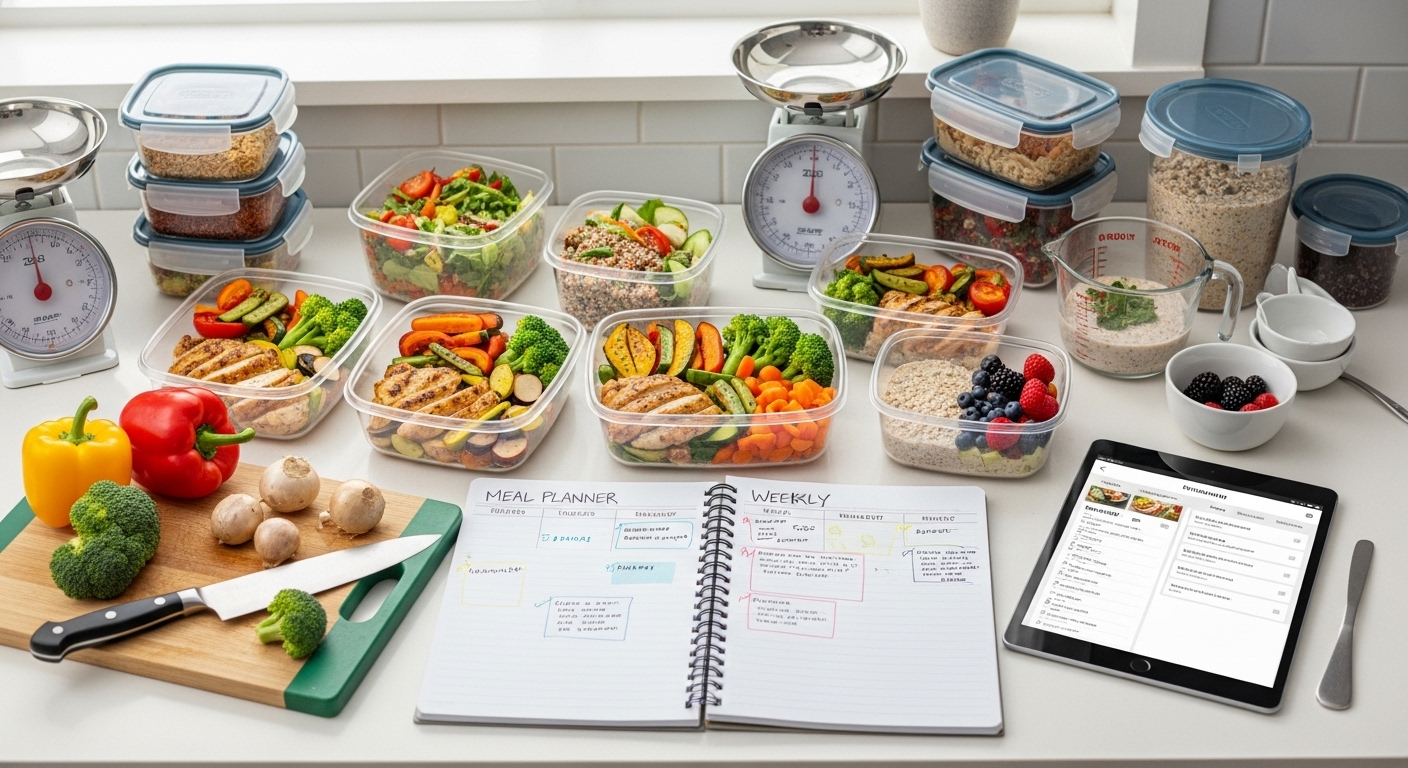
Meal prep is a key strategy to stay consistent, save time, and make healthy eating more convenient. It involves planning your meals in advance, shopping smart, and preparing ingredients or full meals ahead of time.
Benefits of Meal Prep
- ✔ Prevents last-minute unhealthy choices
- ✔ Saves time during the week
- ✔ Helps control portions and meet calorie/macro goals
- ✔ Reduces food waste and saves money
Steps for Effective Meal Prep
- Plan Your Menu: Decide on meals for 3–7 days (breakfast, lunch, dinner, snacks). Choose recipes that fit your goals and include variety.
- Make a Grocery List: Organize by categories and stick to your list to avoid impulse buys.
- Prep Ingredients in Bulk: Wash, chop, and store vegetables; cook proteins and grains in large batches.
- Portion Your Meals: Use meal prep containers and label them with meal name & date.
- Store Properly: Refrigerate for 3–4 days or freeze for 2–3 weeks.
- Include Healthy Snacks: Pre-portion nuts, yogurt cups, fruits, and protein bars.
- Use Time-Saving Tools: Instant Pot, air fryer, and blender for quick meal prep.
✅ Example Meal Prep Plan (3 Days)
- Breakfast: Overnight oats with chia seeds, berries, and almond milk.
- Lunch: Grilled chicken + quinoa + broccoli.
- Dinner: Baked salmon + sweet potato + salad.
- Snacks: Greek yogurt + nuts, apple slices with peanut butter.
Staying Consistent
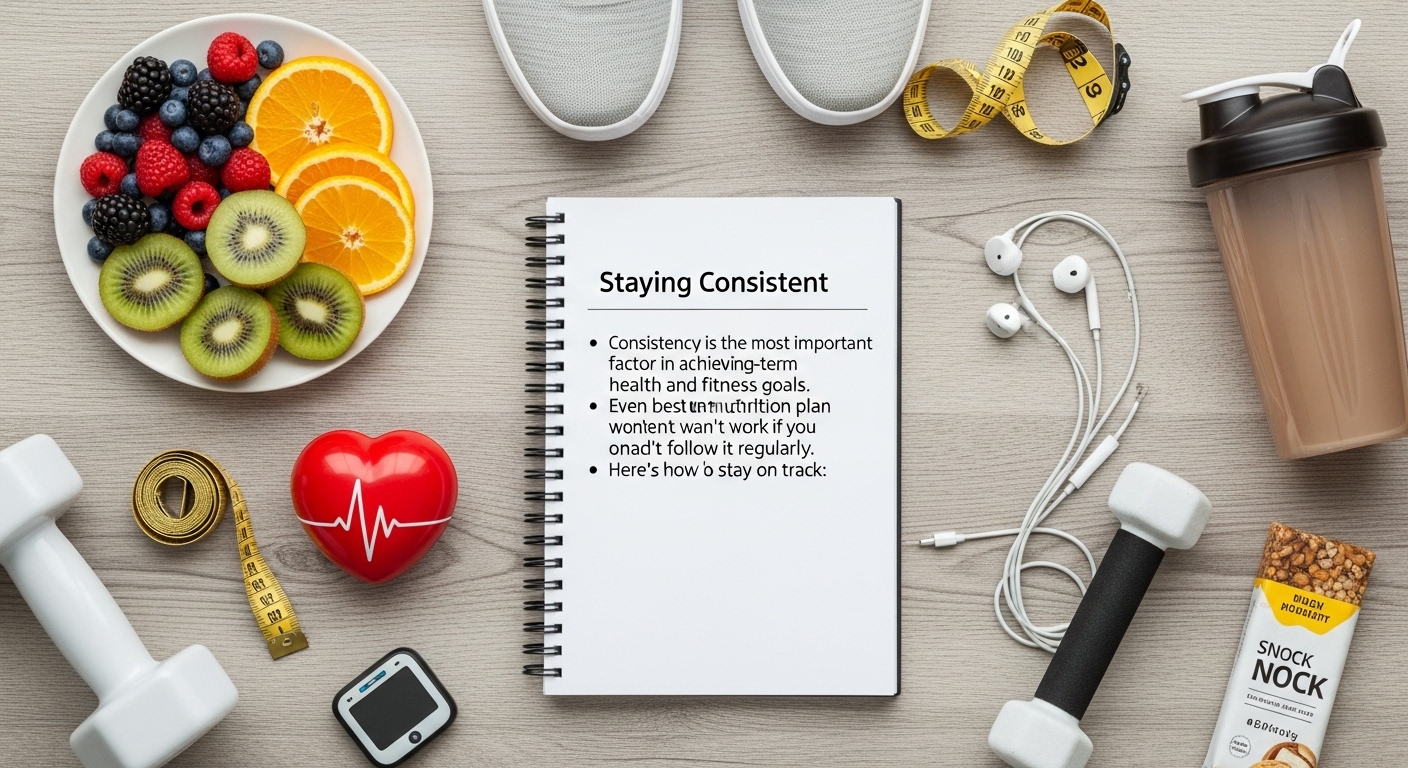
Consistency is the most important factor in achieving long-term health and fitness goals. Even the best nutrition plan won’t work if you don’t follow it regularly. Here’s how to stay on track:
- Set Realistic Goals: Start with achievable calorie and macro targets. Focus on progress, not perfection—small changes add up over time.
- Make It Enjoyable: Include foods you like to avoid feeling restricted. Try healthy versions of your favorite meals.
- Create a Routine: Eat meals at regular times each day. Plan snacks and pre/post-workout meals to prevent impulsive eating.
- Track Your Progress: Use an app or journal to log meals and monitor calorie/macro intake. Track weight, measurements, or photos every 2–4 weeks for motivation.
- Prepare in Advance: Meal prep for busy days so you don’t resort to unhealthy choices. Keep healthy snacks like fruits, nuts, or protein bars handy.
- Avoid All-or-Nothing Thinking: One “cheat meal” won’t ruin your progress—get back on track at the next meal. Focus on consistency over perfection (80/20 rule works great).
- Stay Accountable: Share goals with a friend, coach, or online community. Regular check-ins can boost motivation.
- Manage Cravings Smartly: Drink water first (sometimes thirst feels like hunger). Choose healthier alternatives for sweet or salty cravings.
- Prioritize Sleep & Stress Management: Lack of sleep and high stress can trigger overeating and poor choices. Aim for 7–9 hours of sleep and practice stress relief (yoga, meditation).
- Reward Yourself: Celebrate milestones with non-food rewards like new workout gear or a spa day.
Flexibility and Adjustments
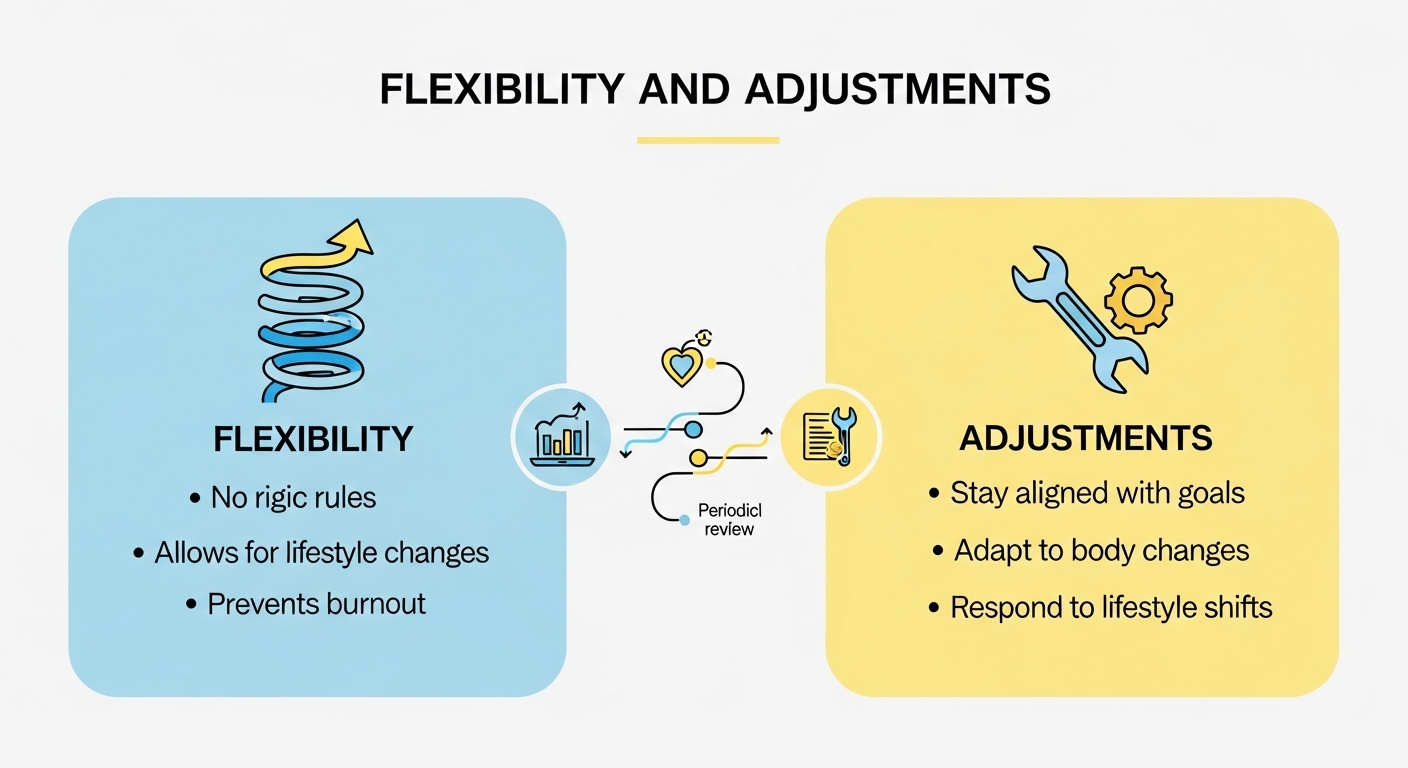
No nutrition plan should feel like a rigid rulebook. Flexibility is essential for long-term success, while adjustments help you stay aligned with your goals as your body and lifestyle change.
Why Flexibility Matters
- Prevents burnout and diet fatigue.
- Allows you to enjoy social events and favorite foods without guilt.
- Helps maintain consistency over time.
How to Add Flexibility
- Use the 80/20 Rule: Stick to your plan 80% of the time, allow 20% flexibility for treats.
- Practice Portion Control: Enjoy indulgent foods in moderation.
- Plan for Social Events: Eat lighter earlier if you expect a big meal.
- Swap, Don’t Skip: Replace high-calorie foods with lighter alternatives.
When and How to Make Adjustments
- Monitor Progress: Track weight, measurements, and energy.
- Adjust Calories: Reduce or increase by 100–250 kcal based on goals.
- Rebalance Macros: Increase protein during weight loss, carbs during training.
- Listen to Your Body: Adjust based on energy, hunger, or digestion.
✅ Key Tip: Flexibility + smart adjustments = sustainable results!
Hydration Tips
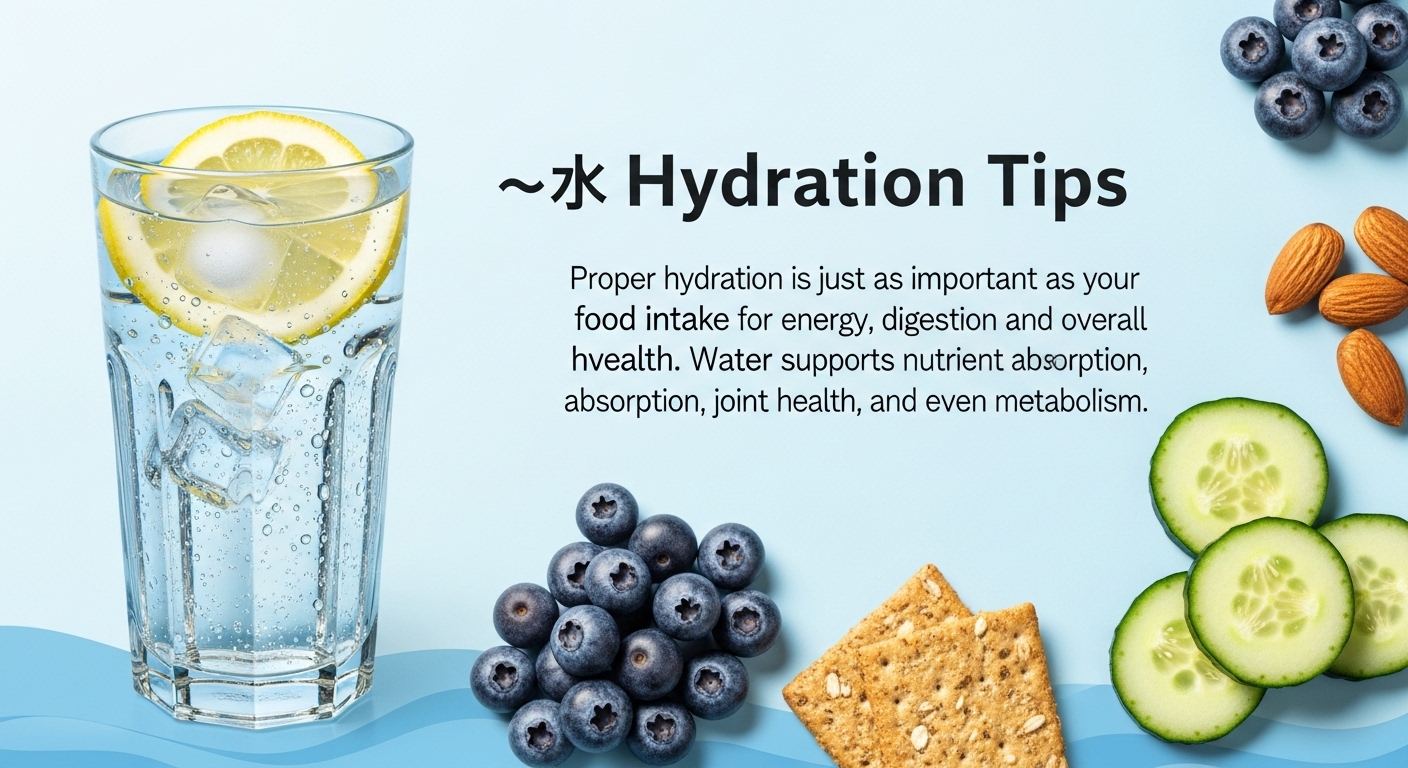
Proper hydration is just as important as your food intake for energy, digestion, and overall health. Water supports nutrient absorption, joint health, and even metabolism.
Why Hydration Matters
- Regulates body temperature.
- Helps in digestion and nutrient transport.
- Improves skin health and energy levels.
- Aids in removing toxins from the body.
Daily Water Requirements
Women: 2–2.5 liters/day
Men: 3–3.5 liters/day
Active individuals: Add 0.5–1 liter per hour of exercise.
✅ Practical Hydration Tips
- Start Your Day with Water: Drink 250 ml after waking up.
- Follow the “8×8 Rule”: Eight 8-ounce glasses (~2 L) daily.
- Sip, Don’t Chug: Drink consistently throughout the day.
- Monitor Urine Color: Pale yellow = good hydration.
- Flavor Naturally: Add lemon, cucumber, or mint.
- Include Hydrating Foods: Watermelon, cucumber, oranges.
- Time Your Intake: 30 mins before meals; avoid chugging after eating.
- Stay Hydrated During Workouts: 400–500 ml before; sip during.
- Limit Dehydrating Drinks: Reduce soda, alcohol, excess caffeine.
- Carry a Bottle: Keep a reusable bottle as a reminder.
✅ Tip: Water is life—drink smart, not just more!
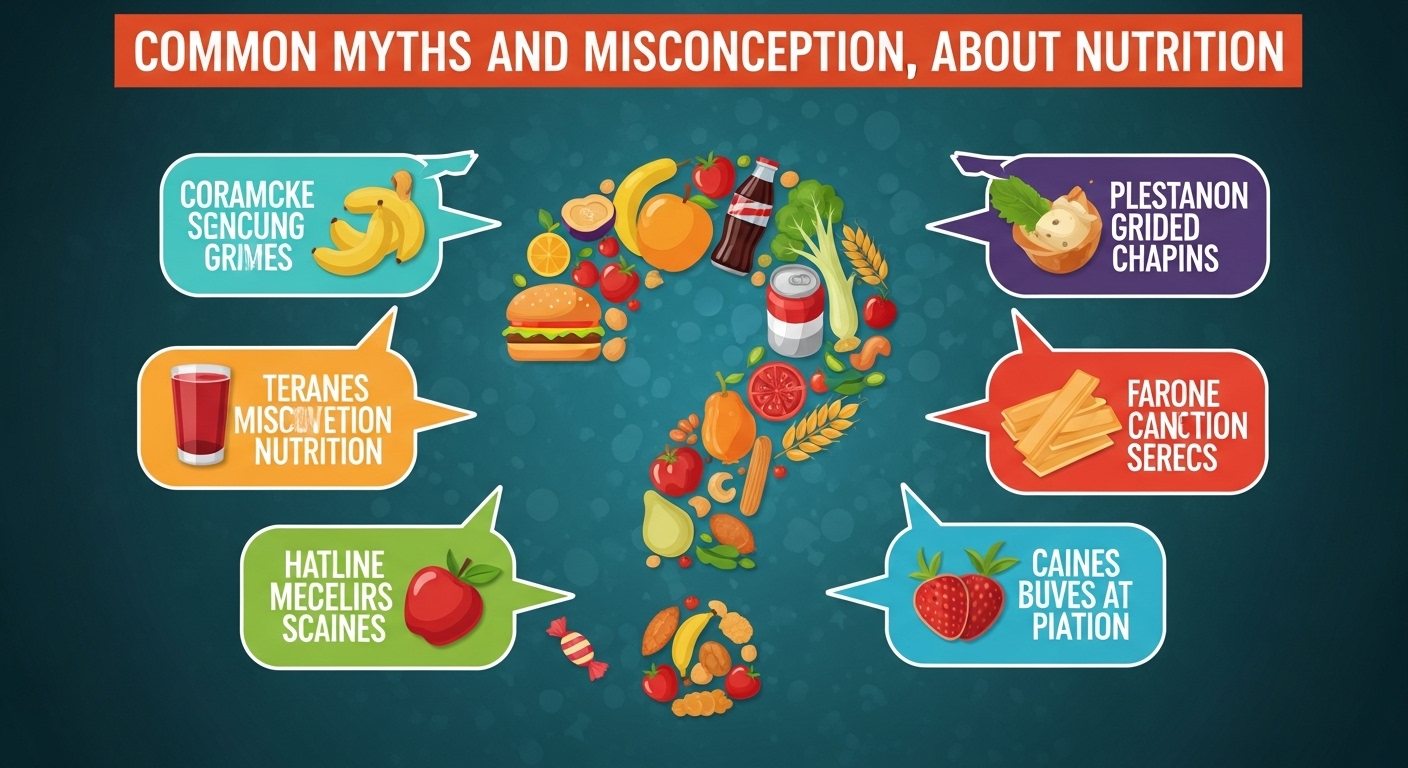
🥗 Common Myths and Misconceptions About Nutrition
Nutrition is a topic filled with confusing advice and myths. Understanding the facts helps you make better choices. Let’s debunk some of the most common myths:
- “Carbohydrates Make You Gain Weight”
Fact: Carbs are an essential energy source. Weight gain happens when you consume more calories than you burn, regardless of macronutrient type.
- “Fat Is Always Bad for You”
Fact: Healthy fats are vital for brain health, hormone production, and vitamin absorption. Avoid trans fats, but include sources like nuts, seeds, and olive oil.
- “You Should Skip Meals to Lose Weight”
Fact: Skipping meals can slow metabolism and cause overeating later. Regular, balanced meals support steady energy and weight management.
- “Eating Late at Night Causes Fat Gain”
Fact: It’s total daily calorie intake, not timing, that affects weight. Eating late is fine if it fits your calorie goals.
- “Detox Diets Are Necessary to Cleanse Your Body”
Fact: Your liver and kidneys naturally detoxify your body. Extreme detox diets can be harmful and lack essential nutrients.
- “All Calories Are Equal”
Fact: While calories matter for weight, food quality impacts health. Nutrient-dense foods support overall well-being better than empty-calorie foods.
- “More Protein Means More Muscle”
Fact: Muscle growth requires a balance of training, adequate protein, and overall calories—not excessive protein alone.
- “Supplements Can Replace Real Food”
Fact: Supplements support your diet but cannot replace the vitamins, minerals, and fiber found in whole foods.
- “Natural Sugars Are Bad”
Fact: Natural sugars in fruits come with fiber and nutrients and are healthy in moderation. Added sugars in processed foods are the main concern.
- “High-Protein Diets Harm Kidneys”
Fact: Healthy individuals can safely consume higher protein without kidney damage. Those with kidney issues should consult a doctor.
Fad Diets
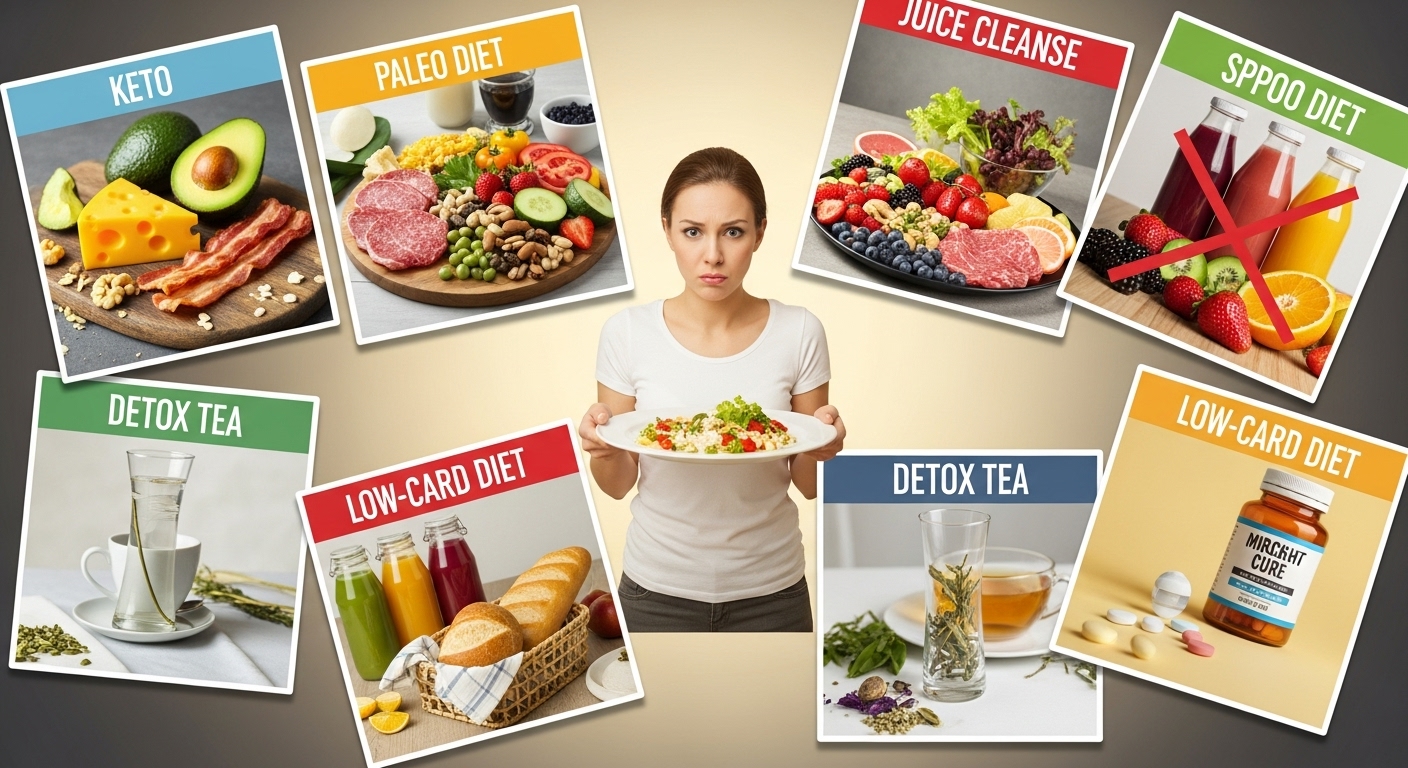
Fad diets are popular eating plans that promise quick weight loss or health benefits, often with strict or unusual rules. While they might offer short-term results, they can be unsustainable or even harmful in the long run.
Common Characteristics of Fad Diets
- Promote rapid weight loss.
- Eliminate entire food groups (e.g., carbs or fats).
- Rely heavily on specific “superfoods” or supplements.
- Lack scientific backing or balanced nutrition.
- Often difficult to maintain long-term.
Examples of Popular Fad Diets
- Keto Diet: Very low carb, high fat.
- Juice Cleanses: Liquid-only fasts for detox.
- Paleo Diet: Focuses on “caveman” foods, excludes grains and dairy.
- Detox Diets: Short-term fasting or restrictive eating to cleanse the body.
- Intermittent Fasting (when done without guidance): Skipping meals without considering nutrient needs.
Why Fad Diets Can Be Problematic
- Nutrient deficiencies due to food group elimination.
- Muscle loss along with fat loss.
- Metabolic slowdown with extreme calorie restriction.
- Can trigger unhealthy relationships with food.
- May cause energy crashes, mood swings, and cravings.
How to Approach Dieting Wisely
- Focus on balanced, sustainable eating habits.
- Include a variety of whole foods from all food groups.
- Make gradual changes that you can maintain.
- Consult a healthcare professional or dietitian before starting restrictive diets.
Better Alternatives
- Personalized nutrition plans based on your goals and preferences.
- Emphasis on nutrient quality and portion control.
- Consistency over quick fixes.
Carbs vs. Fat: Which Is Better?
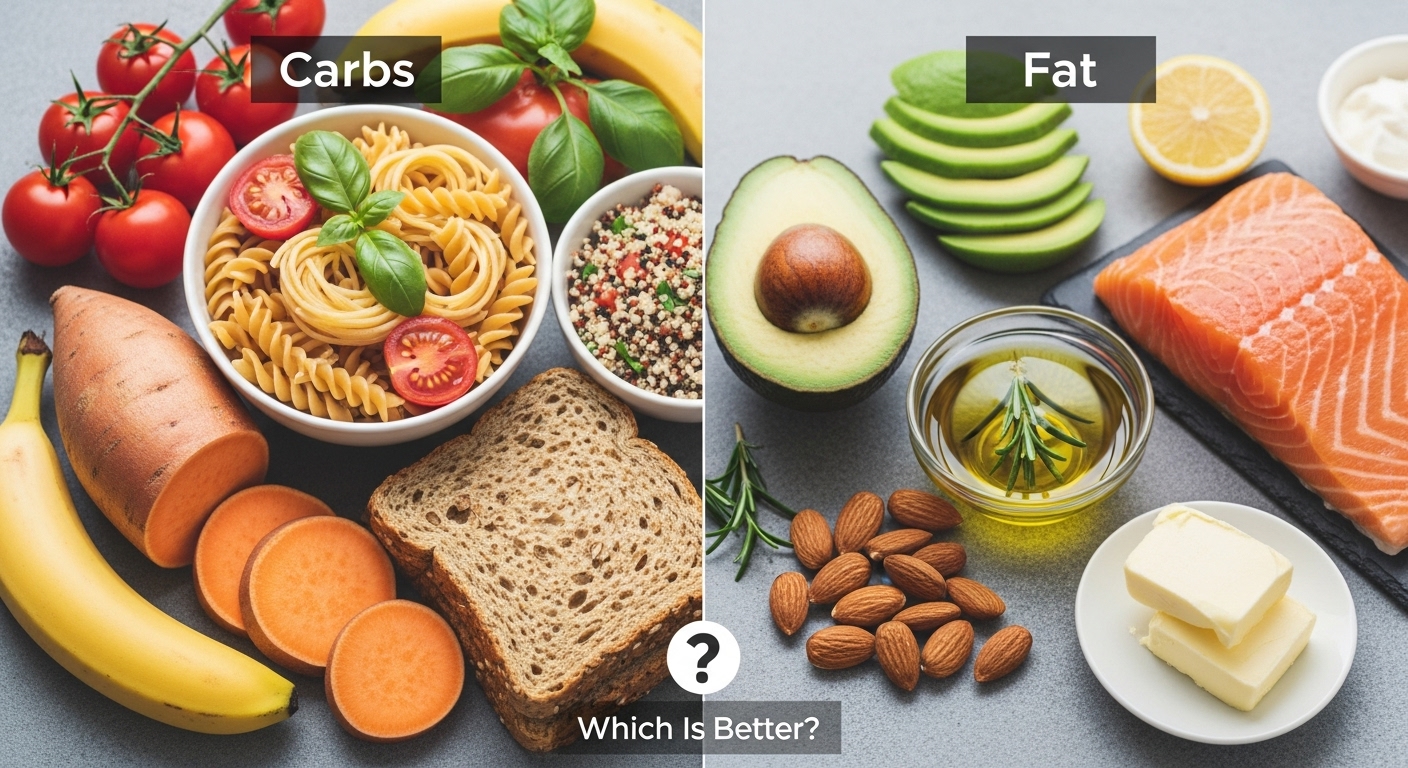
The debate between carbohydrates and fats often confuses people trying to eat healthy or lose weight. Both are essential macronutrients, but their roles and effects on the body differ.
Role of Carbohydrates
- Primary energy source for the body and brain.
- Stored as glycogen in muscles and liver for quick energy.
- Found in foods like grains, fruits, vegetables, legumes.
Recommended Intake: 45–65% of daily calories (for general health).
Best sources: Whole grains, fruits, vegetables.
Role of Fats
- Energy reserve and supports cell structure.
- Helps absorb fat-soluble vitamins (A, D, E, K).
- Important for hormone production and brain health.
Recommended Intake: 20–35% of daily calories.
Best sources: Olive oil, nuts, seeds, omega-3-rich fish.
Which One to Limit?
Avoid refined carbs (white bread, sugary snacks) and trans fats (processed junk).
Choose complex carbs and healthy fats for optimal health.
✅ Carbs vs. Fat for Weight Loss
- Both can work if calorie intake is controlled.
- Low-carb diets may help with quick water weight loss.
- Low-fat diets reduce calorie density but may leave you feeling hungry.
- Balanced approach works best for sustainability.
✅ Ideal Ratio for Most People
Moderate carbs + healthy fats + adequate protein = long-term success.
Example (2000 kcal diet):
Carbs: 50% → 250 g
Fats: 30% → 67 g
Protein: 20% → 100 g
Supplements: Do You Really Need Them?

Supplements are products designed to provide nutrients that may be missing or insufficient in your diet. While they can be useful, they are not a substitute for real food. Whole foods provide fiber, antioxidants, and other compounds that supplements cannot replicate.
Common Types of Supplements
- Multivitamins – Cover general vitamin and mineral needs.
- Protein Powders – Convenient way to meet protein goals (whey, casein, plant-based).
- Omega-3 Fatty Acids – Fish oil or algae oil for heart and brain health.
- Vitamin D – Important for bone health, especially if sun exposure is low.
- Creatine – Improves strength and muscle performance.
- Probiotics – Support gut health.
- Electrolytes – Useful for hydration after intense workouts or heat exposure.
When Supplements Are Helpful
- You have nutrient deficiencies (confirmed by blood tests).
- Restrictive diets (vegan/vegetarian, keto) limit certain nutrients.
- Busy lifestyle where meeting protein or micronutrient goals is hard.
- During intense training or recovery.
When to Avoid or Be Cautious
- If relying on supplements instead of real food.
- Without professional guidance, especially for fat burners or detox products.
- Overdosing on vitamins (e.g., fat-soluble vitamins A, D, E, K can cause toxicity).
✅ Key Tips for Using Supplements
- Food First: Always aim to meet most needs through a balanced diet.
- Check Labels: Choose reputable brands with third-party testing.
- Consult a Professional: Before starting any supplement, especially if you have medical conditions.
- Stay Within Safe Limits: More is not always better.
Bottom Line: Supplements support, they do not replace healthy eating.

When to Consult a Professional
While general nutrition advice can help most people, certain situations require personalized guidance from a qualified expert, such as a registered dietitian, nutritionist, or healthcare professional.
-
Unexplained Weight Changes: Rapid weight loss or gain without changes in diet or exercise.
Could indicate underlying hormonal, thyroid, or metabolic issues.
-
Chronic Health Conditions: Diabetes, heart disease, kidney issues, digestive disorders.
Requires a specialized meal plan to manage health and avoid complications.
-
Severe Food Allergies or Intolerances: Gluten, dairy, nuts, or multiple food sensitivities.
Risk of nutrient deficiencies if eliminating food groups.
-
Nutrient Deficiencies: Low iron, vitamin D, calcium, or B12 confirmed by tests.
Professional guidance ensures safe supplementation and diet adjustments.
-
Eating Disorders or Disordered Eating Patterns: Conditions like anorexia, bulimia, binge eating.
Needs medical and psychological support.
-
Pregnancy or Breastfeeding: Increased needs for iron, folic acid, calcium, and protein.
Must ensure safe and adequate nutrition for mother and baby.
-
Children and Teen Nutrition: Growth periods require balanced diets for development.
Helps manage picky eating or obesity risks.
-
Athletes and High-Performance Goals: Sports nutrition for muscle gain, endurance, or fat loss.
Needs personalized macro and hydration planning.
-
Digestive Issues: Persistent bloating, IBS, or food sensitivities.
May require a specialized elimination or low-FODMAP diet.
✅ Key Tip: If you experience persistent symptoms, major lifestyle changes, or have complex goals, consulting a professional ensures safety and long-term success.
Dietitians & Nutritionists: Who They Are and How They Help

When it comes to professional nutrition advice, you’ll often hear about dietitians and nutritionists. While their roles may seem similar, there are important differences in their qualifications, responsibilities, and how they can help you.
Who is a Dietitian?
Registered Dietitian (RD) or Registered Dietitian Nutritionist (RDN)
- Bachelor’s or Master’s degree in dietetics or nutrition science.
- Supervised clinical experience.
- Pass a national registration exam.
- Often licensed or regulated by a governing body.
What They Do:
Create medical nutrition therapy plans for patients with health conditions. Work in hospitals, clinics, private practice, and research. Provide clinical nutrition guidance for diabetes, kidney disease, obesity, etc.
Who is a Nutritionist?
Broader term; requirements vary by region. Some have formal training in nutrition science, others may not. In some countries, anyone can call themselves a “nutritionist” without certification.
What They Do:
Offer general nutrition advice for healthy eating and weight management. Work in fitness centers, wellness programs, corporate health initiatives. Focus on preventive health and lifestyle coaching rather than clinical care.
✅ Key Differences
| Aspect |
Dietitian (RD/RDN) |
Nutritionist |
| Education |
Degree + clinical training |
Varies (may be formal or none) |
| Certification |
Required |
Optional in most places |
| Scope |
Clinical & medical nutrition |
General nutrition & wellness |
| Regulation |
Highly regulated |
Not strictly regulated |
When to Choose Each
- Dietitian: For medical conditions like diabetes, heart disease, allergies, eating disorders.
- Nutritionist: For general health, fitness goals, meal planning, weight management.
✅ Why Consult Them?
Avoid misinformation and fad diets.
Get personalized plans based on your body, lifestyle, and goals.
Ensure safe and sustainable results.
Medical Considerations in Nutrition
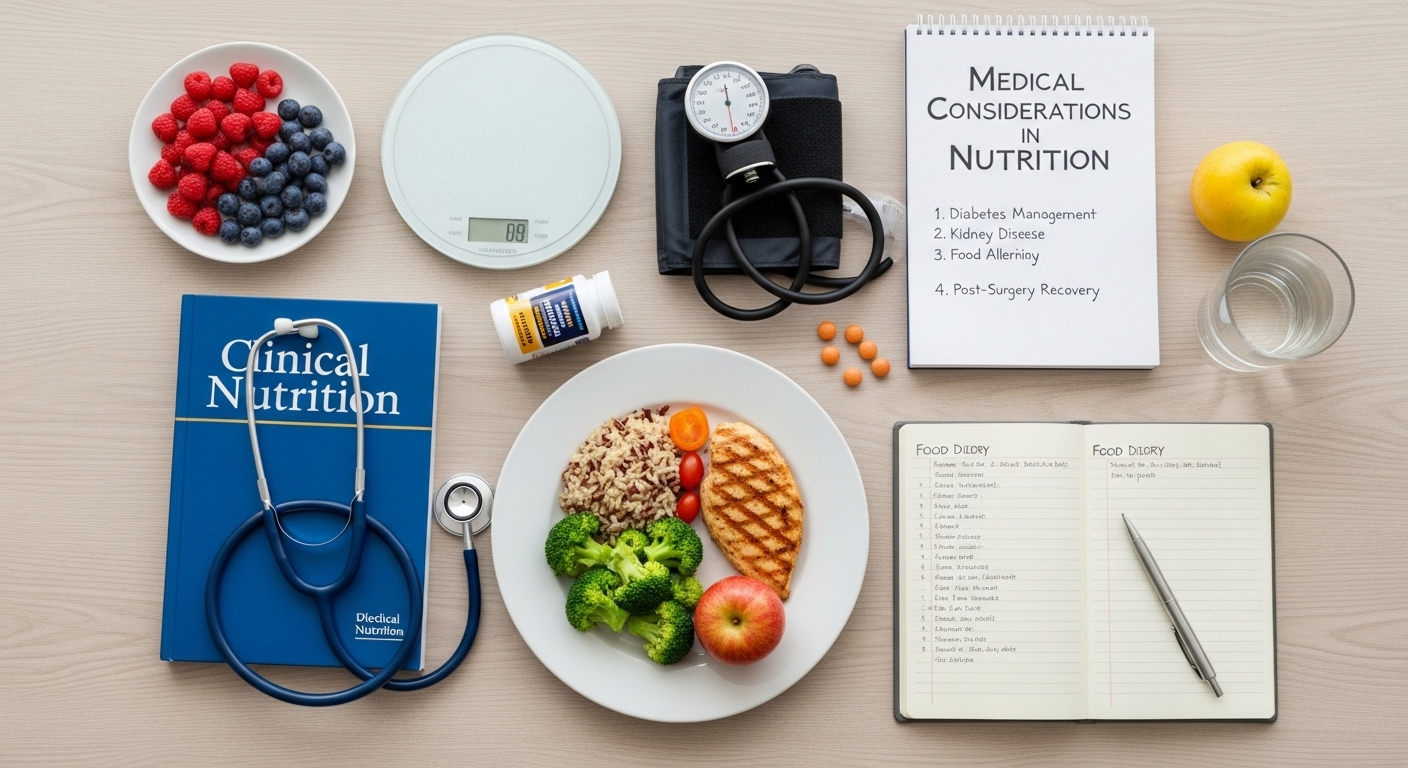
Proper nutrition is essential for everyone, but individuals with certain medical conditions require specialized dietary care to manage their health effectively and prevent complications.
-
Diabetes Management: Focus on balanced carbohydrate intake to control blood sugar. Monitor glycemic index of foods. Avoid excessive sugars and refined carbs. Incorporate fiber-rich foods to slow glucose absorption.
-
Heart Health: Limit saturated fats, trans fats, and cholesterol. Emphasize healthy fats like omega-3s from fish, nuts, and seeds. Reduce sodium intake to control blood pressure. Eat plenty of fruits, vegetables, and whole grains.
-
Kidney Disease: Control protein intake based on disease stage. Limit phosphorus, potassium, and sodium as advised. Stay hydrated but avoid fluid overload. Work closely with a dietitian for safe meal planning.
-
Food Allergies and Intolerances: Identify and eliminate trigger foods (e.g., gluten, lactose, nuts). Find nutrient substitutes to prevent deficiencies. Read labels carefully to avoid hidden allergens.
-
Digestive Disorders: Conditions like IBS, Crohn’s, ulcerative colitis require tailored diets. Low-FODMAP diet may help reduce symptoms. Avoid irritants like caffeine, alcohol, and spicy foods.
-
Weight-Related Health Issues: Obesity increases risk for diabetes, heart disease, and joint problems. Nutrition plans focus on calorie deficit, balanced macros, and sustainable habits.
-
Pregnancy and Lactation: Increased needs for iron, folate, calcium, and protein. Avoid certain foods (e.g., raw fish, unpasteurized dairy). Focus on nutrient-dense, safe foods for mother and baby.
✅ Working with Healthcare Providers: Always inform your healthcare team about your diet. Regular monitoring and lab tests help adjust nutrition plans safely. Personalized care improves health outcomes.

















